Haiyore! Nyaruko-san Episode 4 References
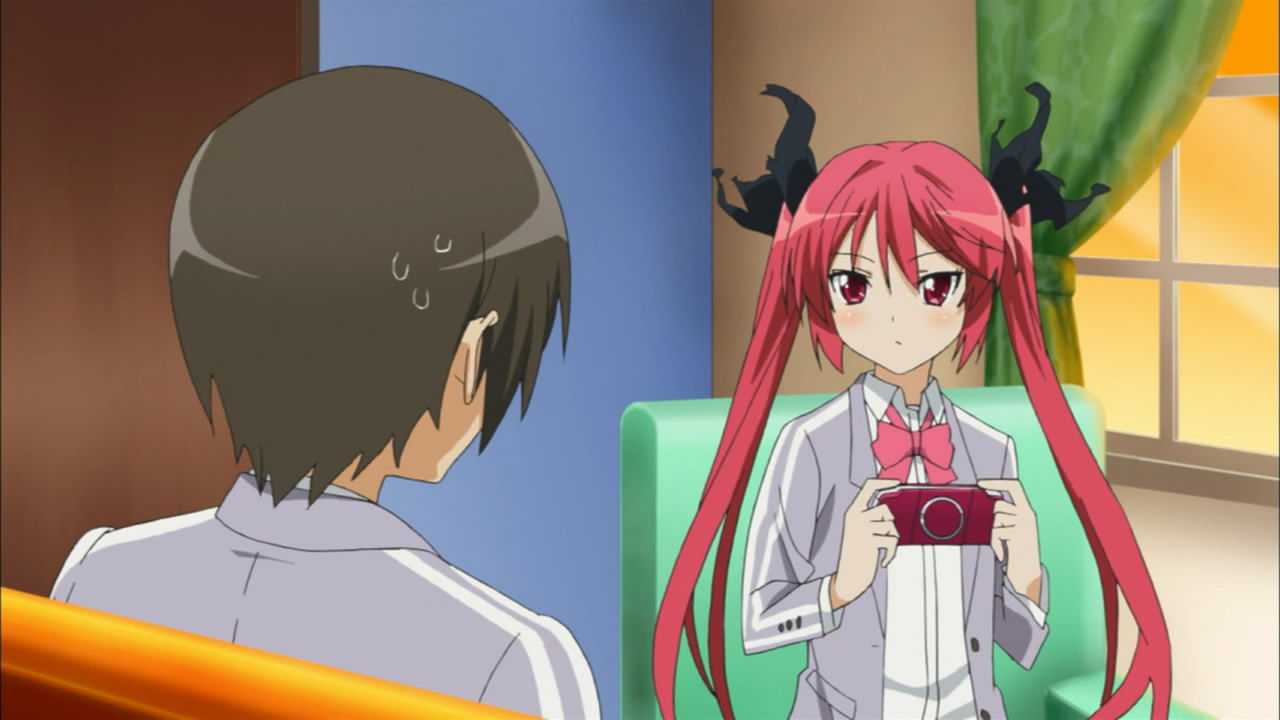
(0:28)
The game device Cthuko is playing with is based on the PlayStation Portable (プレイステーション・ポータブル), a handheld video game console released by Sony (ソニー) in 2004. Image for reference:
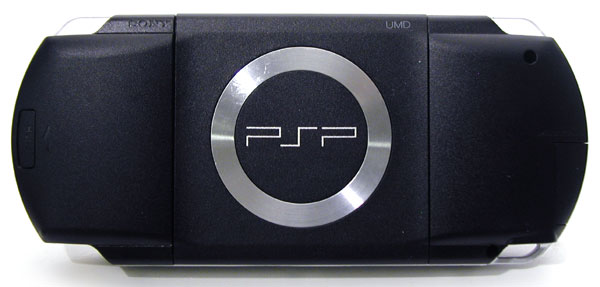
Source of image: http://www8.pcmag.com/media/images/93527-sony-psp-back.jpg

(0:58)
There are two references here:
• There is a gray device on floor:
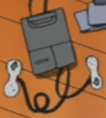
This device appears to be based on the "Family Computer (HVC-101)" (ファミリーコンピュータ (HVC-101)), a video game console released by Nintendo (任天堂) in 1993. Image for reference:

Source of image: https://en.wikipedia.org/wiki/File:New_Famicom.jpg
• The is a red figure on the floor:

This figure appears to be based on a combat vehicle known as Char's Zaku (シャア専用ザク) from "Mobile Suit Gundam" (機動戦士ガンダム), an anime series that aired from 1979 to 1980. Image for reference:
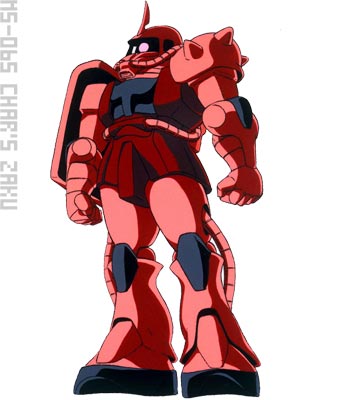
Source of image: http://www.gundam.jp/tv/world/mecha/ze01.html
"I have come all the way from the future... Correction, from a distant planet..." (3:26)
The Japanese line is "Mirai, motoi hoshi no kuni kara harubaru to yatte mairimashita!" (未来、もとい星の国からはるばるとやって参りました!). This is referencing the title of chapter 1 of volume 1 of "Doraemon" (ドラえもん), a manga series written by Fujiko F. Fujio (藤子・F・不二雄) and published from 1969 to 1996.S1 The original chapter title is "Mirai no kuni kara harubaru to" (未来の国からはるばると), which translates to "Arriving from the distant future". Image for reference:
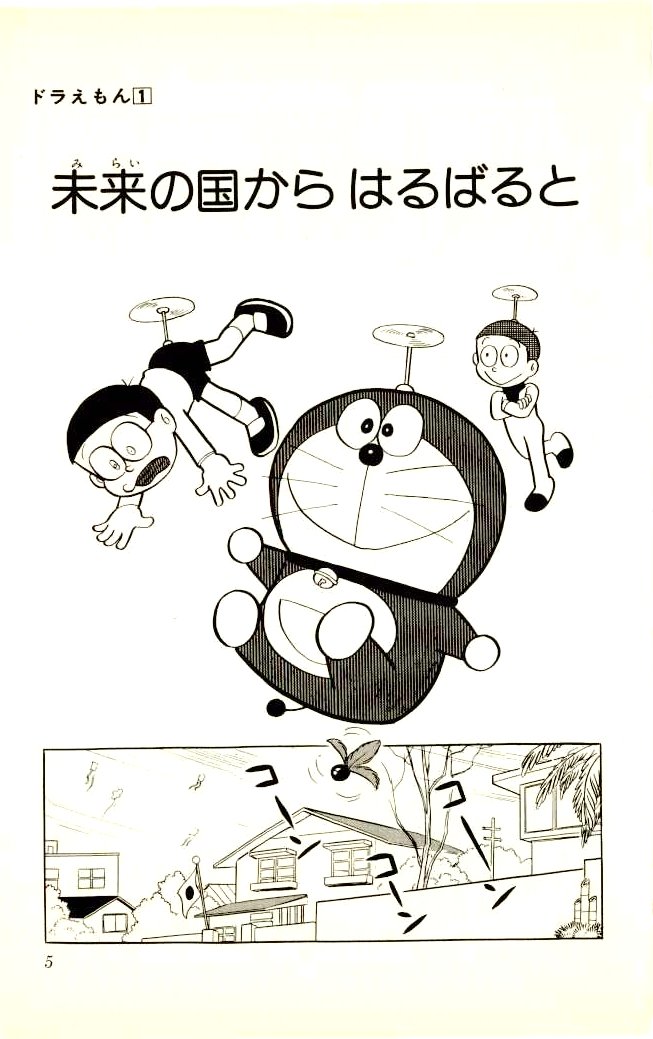
This title is also used as the title for the first episode of the anime adaptation of "Doraemon".
"Is your brain a flower garden farm!?" (3:52)
The Japanese line is "Noumiso ohanabatake bokujou desu ka!?" (脳味噌お花畑牧場ですか!?). There are two references here:
* This is referencing "noumiso ohanabatake" (脳味噌お花畑), or more commonly "nounai ohanabatake" (脳内お花畑), a Japanese expression which literally translates to "brain is a flower garden".S4 This expression is used figuratively to evoke the impression that a person's mind is peaceful or tranquil like a flower garden. It can be used to mean someone is carefree or thoughtless, however it can also be used to mean someone is crazy or delusional.
* Specifically "ohanabatake bokujou" (お花畑牧場), "flower garden farm", is referencing Hanabatake Bokujou (花畑牧場), Hanabatake farm, a farm in Hokkaido that is famous for its caramel.S4 On a related note, the author of the "Haiyore! Nyaruko-san" light novel series, Aisora Manta (逢空万太), was born in Sapporo, Hokkaido.
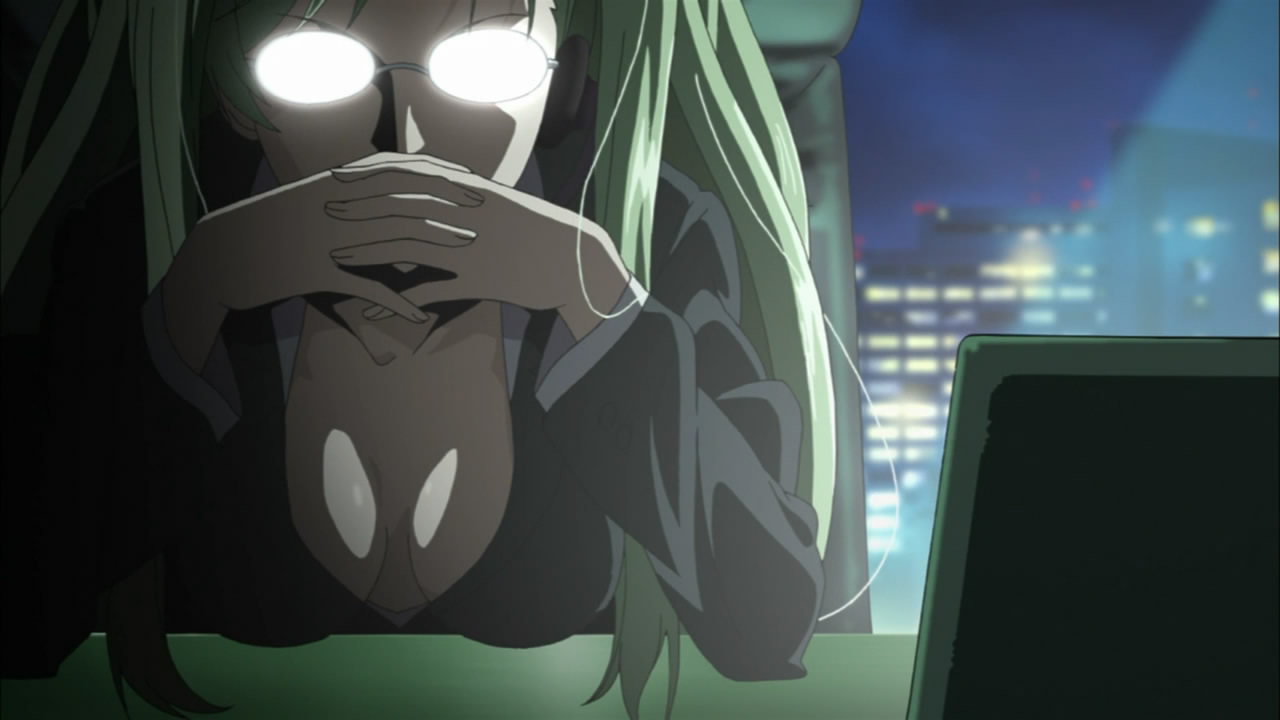
(5:30)
This pose is referencing that of Ikari Gendou (碇ゲンドウ) from "Neon Genesis Evangelion" (新世紀エヴァンゲリオン), an anime series that aired from 1995 to 1996.S1 Image for reference:

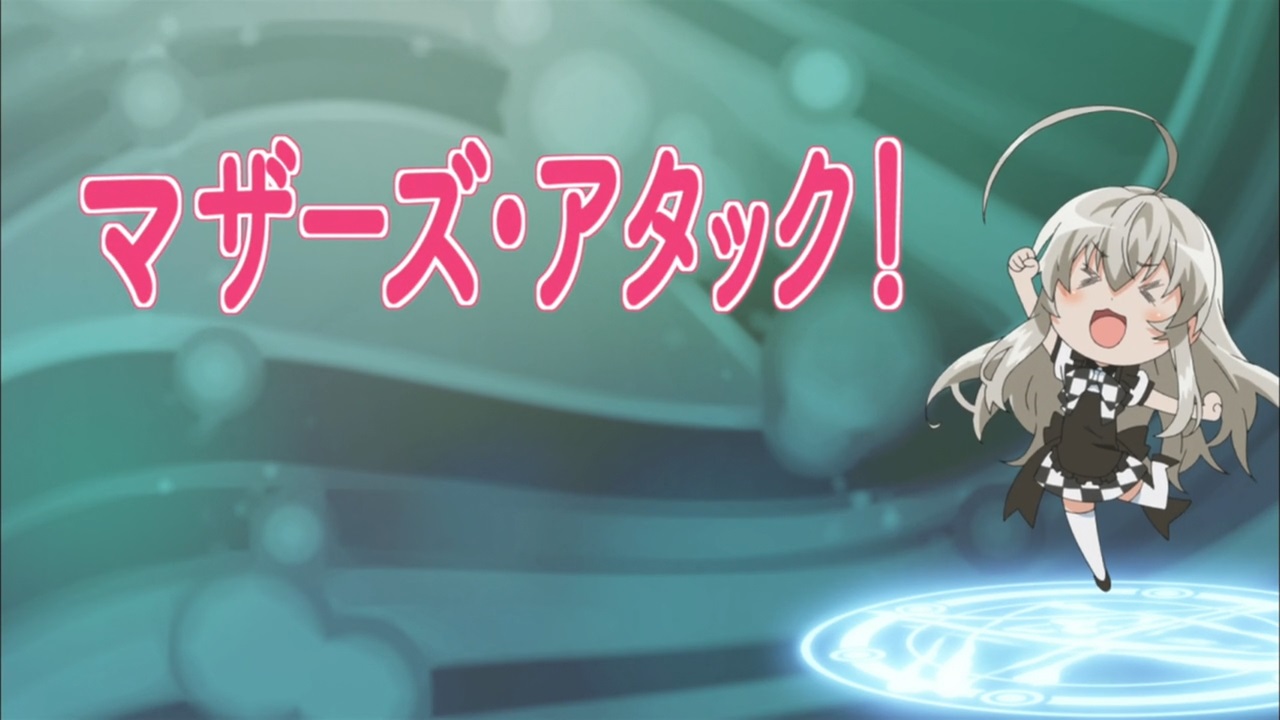
(5:39)
There are two references here:
* The title of this episode is "Mazaazu Atakku!" (マザーズ・アタック!), which translates to "Mothers Attack!". This is referencing "Maazu Atakku" (マーズ・アタック!), "Mars Attacks!", an American movie released in 1996.S1
* The title appears to be based on "Mother's Counter Attack", the title of chapter 1 of volume 4 of the "Haiyore! Nyaruko-san" light novel series. In this chapter, Mahiro's mom suddenly returns home to Mahiro's surprise, similar to in this episode. The title "Mother's Counter Attack" is referencing "Mobile Suit Gundam: Char's Counterattack" (機動戦士ガンダム 逆襲のシャア), a movie released in 1988.S1

(5:56)
There are two references here:
* The blue book in the background reads "Kutouuruu Shinwa no Nazo" (クトゥルー神話の謎), which translates to "Mysteries of the Cthulhu Mythos". This appears to be referencing "Kutouuruu Shinwa no Nazo to Shinjitsu" (クトゥルー神話の謎と真実), "Mysteries and Truths of the Cthulhu Mythos", a book published in 2007.S6 Here is an isolation that might be easier to read:

* The green book in the background reads "Salvador Dali", the name of a famous Spanish surrealist painter.S6 Here is an isolation that might be easier to read:

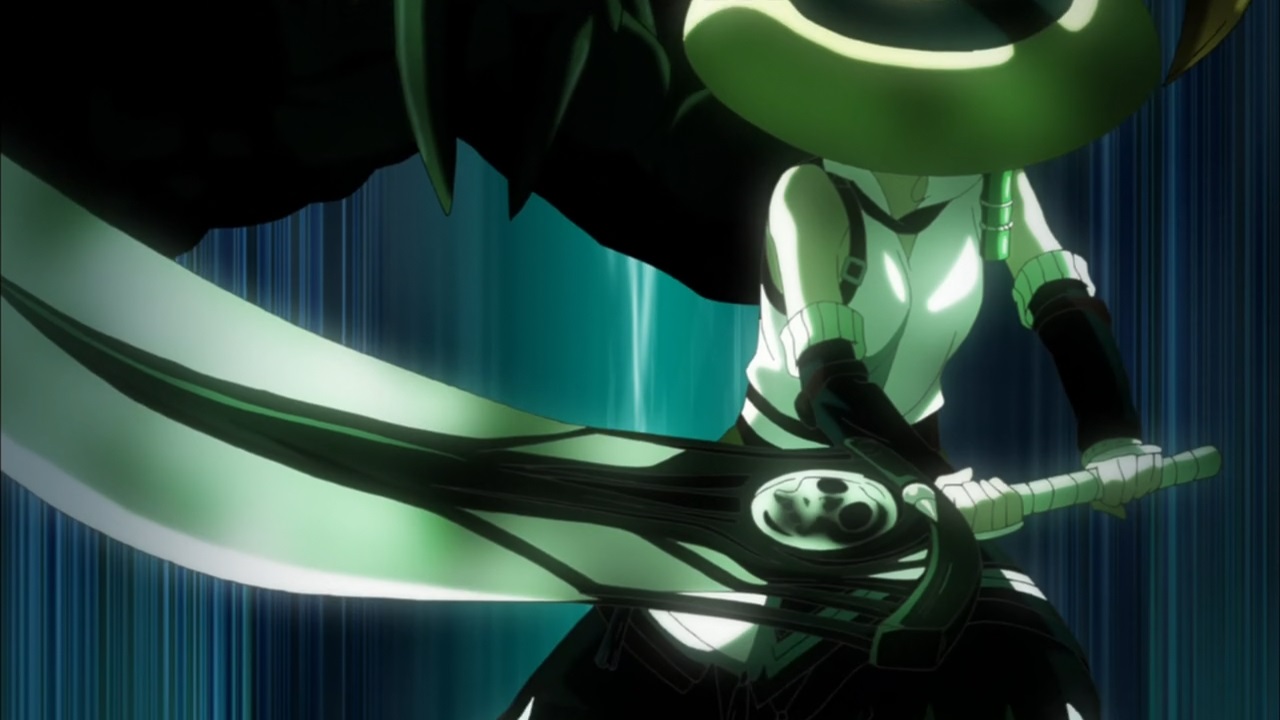
"Let's go hunting!" (6:22)
There are three references here:
* The Japanese line is "Hitokari iku wa yo!" (一狩りいくわよ!). This is referencing "Hitokari Ikou ze!" (一狩りいこうぜ!), "Let's Go Hunting!", a Japanese variety show with the Monster Hunter (モンスターハンター) video game series as its theme.S1
* Yoriko's outfit is referencing the Yukumo (ユクモ) armor from "Monster Hunter Portable 3rd" (モンスターハンターポータブル 3rd), a video game released by CAPCOM (カプコン) in 2010.S3 Image for reference:
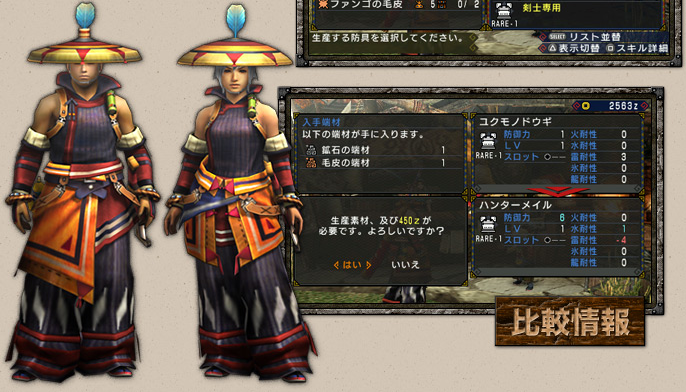
Source of image: https://www.capcom.co.jp/monsterhunter/P3rd/armer.html
* The appearance of the sword Yoriko is wielding is the same as that of the sword Cthuko wields in chapter 2 of volume 5 of the "Haiyore! Nyaruko-san" light novel series. Illustration from the light novel for reference:
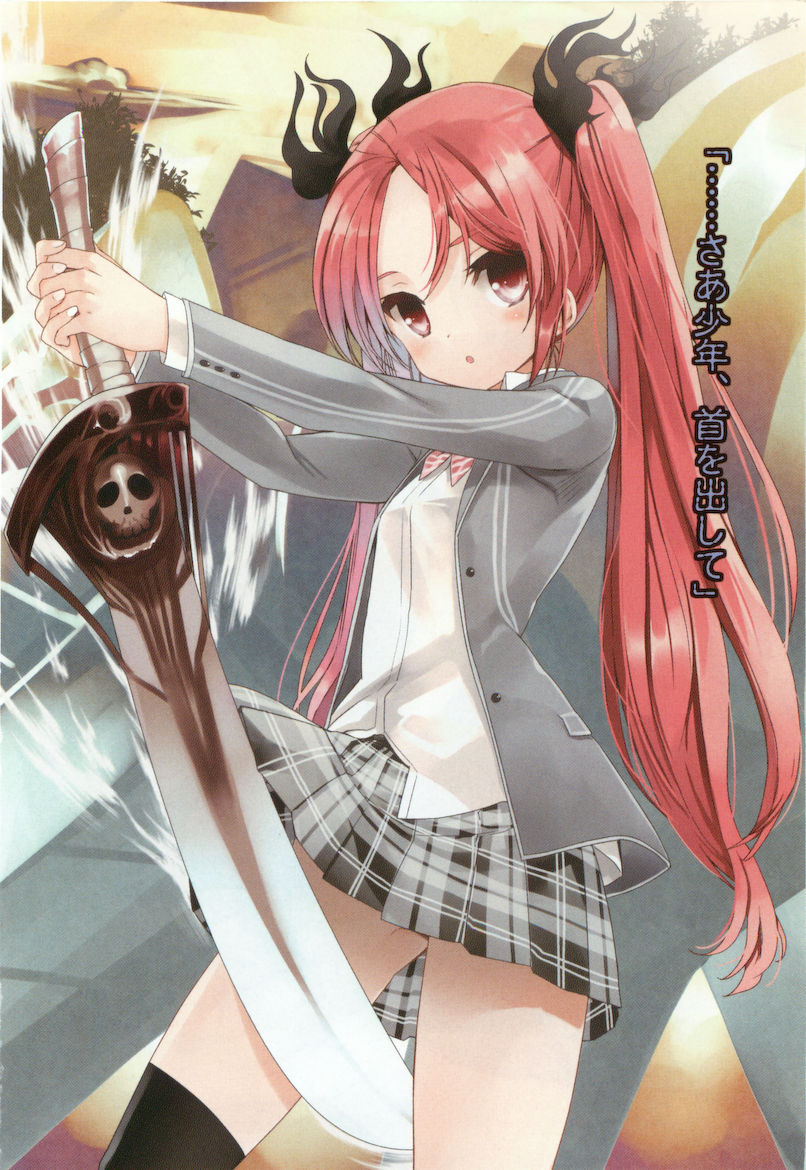
For more details about the sword, please check the episode 8 post at 10:55.


(6:24)
The scenery here resembles an area called "Keiryuu" (渓流), "Mountain Stream", in "Monster Hunter Portable 3rd" (モンスターハンターポータブル 3rd). Image for reference:
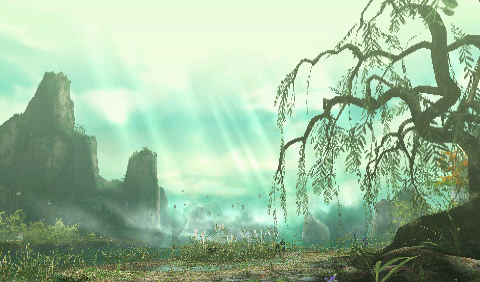
Source of image: https://www.capcom.co.jp/monsterhunter/P3rd/field1.html
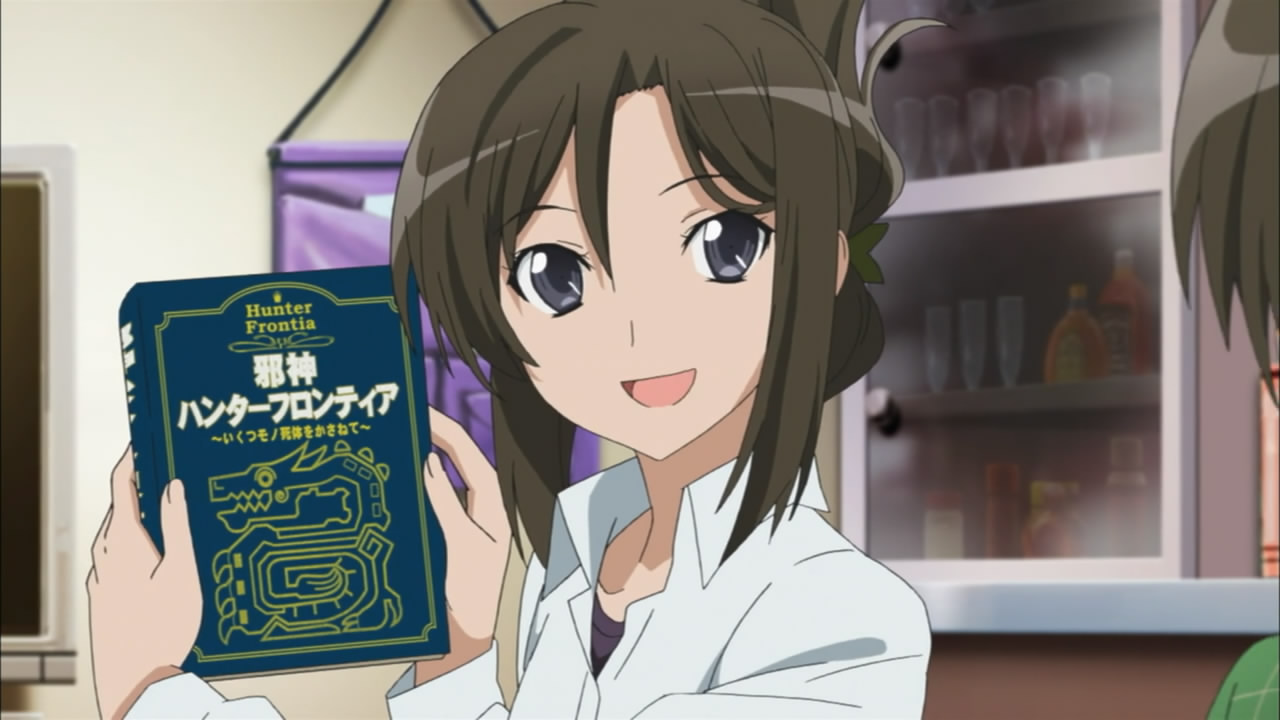
(6:38)
There are three references here:
* The title of the book is "Jashin Hantaa Furontia" (邪神ハンターフロンティア), which translates to "Evil God Hunter Frontier". This is referencing "Monster Hunter Frontier" (モンスターハンター フロンティア), a video game released by CAPCOM (カプコン) in 2013.S1
* The subtitle of the book is "Ikutsu Mono Shitai wo Kasanete" (いくつモノ死体をかさねて), which translates to "With Many Corpses Once More". This is referencing "Ikutsu Mono Ai wo Kasanete" (いくつもの愛をかさねて), "With Much Love Once More", a song sung by Iwasaki Motoyoshi (岩崎元是) and released in 1994. This song is used in episodes 50 and 51 of "Mobile Suit Victory Gundam", (機動戦士Vガンダム), an anime series that aired from 1993 to 1994.S3
* The appearance of the book is based on "Hantaa daizen 3" (ハンター大全3), "Hunter's Encyclopedia 3", a Japanese book containing artwork from the "Monster Hunter" (モンスターハンター) video game series.S1 Image for reference:
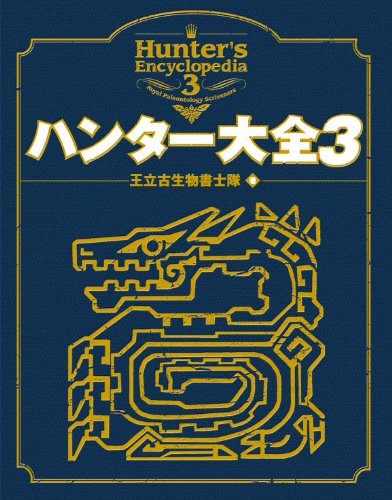
Source of image: https://www.amazon.co.jp/dp/4047265039
"In your case, I bet there's a 'craft' hiding after the 'love.'" (7:04)
This is referencing H. P. Lovecraft, the author whose works led to the creation of the Cthulhu Mythos that "Haiyore! Nyaruko-san" is based on.
"Nyaruko, let's be kissy kissy lovey dovey together. Let's pass on all sorts of weapons and defensive gear to our child." (7:08)
The Japanese line is "Watashi to chucchu rabyurabyu shiyou" (私とちゅっちゅらびゅらびゅしよう). This is referencing "Elminage II ~Sousei no Megami to Unmei no Daichi~" (エルミナージュII 〜双生の女神と運命の大地〜), Elminage II ~The Twin Goddesses and the Land of Destiny~, a video game released in 2009.S1 In the game there is a marriage system that fans nicknamed "chucchu rabyurabyu" (ちゅっちゅらびゅらびゅ), which translates to "kiss kiss love love". A child born from this system can inherit the skills and weapons of its parents.
"We still have the responsibility of protecting Earth's Dreamland." (8:21)
As mentioned in episode 3, the Dreamland is a fictional location in the Cthulhu Mythos that humans can enter when they fall asleep.
"I'm extremely seriously in love with him!" (9:11)
The Japanese line is "Geki maji ni rabu tte masu!" (激マジにラブってます!). This appears to be referencing a line said by Omachi-chan (おまちちゃん) in "Gyousatsu Shinsengumi" (行殺・新選組), a visual novel released in 2000.S1 Her original line goes, "Geki maji de rabu tte masu n de zehi!" (激マジでラブってますんでぜひ!), which translates to "I'm extremely seriously in love with him for sure!".
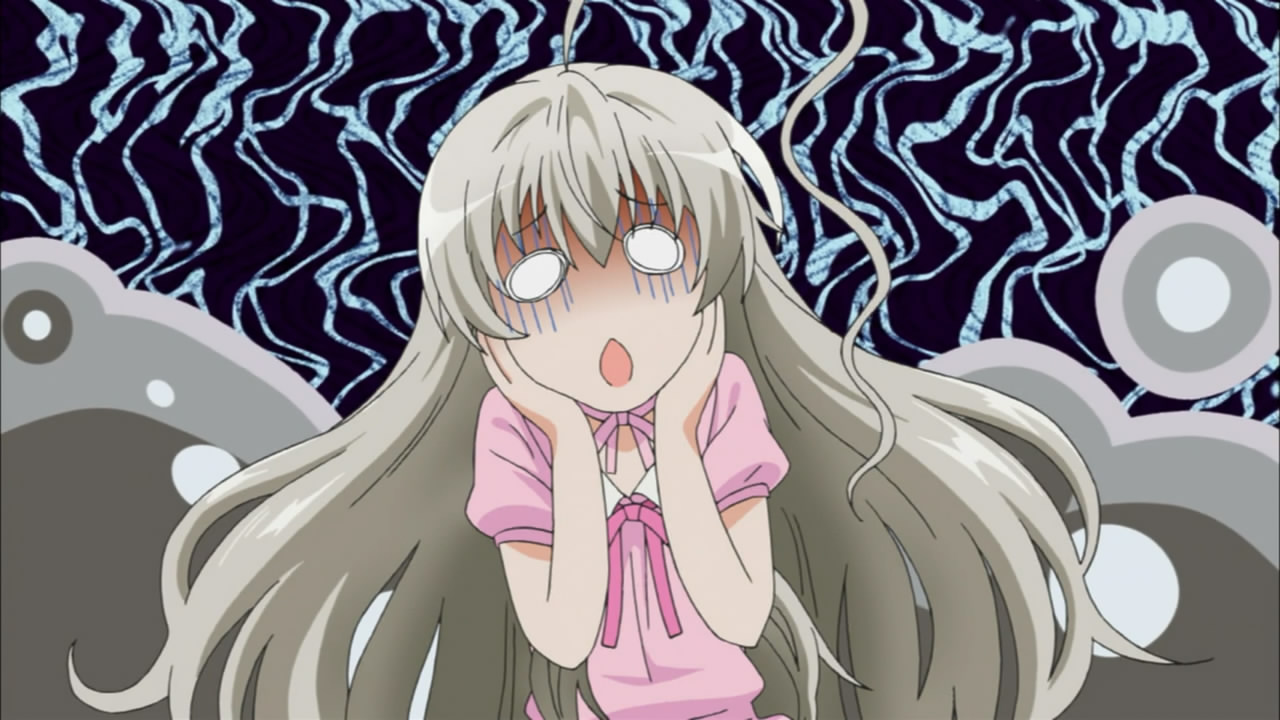
(9:29)
Nyaruko's pose and expression are referencing "The Scream", a painting painted by Edvard Munch in 1893.S2 Image for reference:
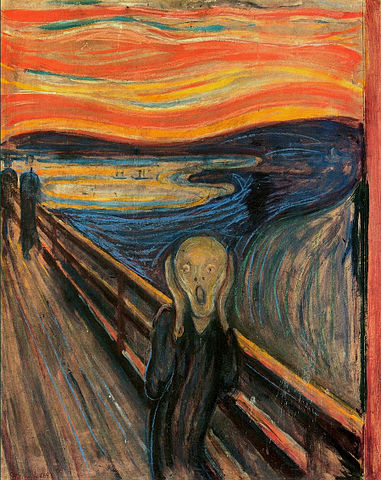
Source of image: https://en.wikipedia.org/wiki/File:The_Scream.jpg
"She's quickly losing sanity points." (9:46)
There are two references here:
* "SAN chi" (SAN値), "sanity points", is a parameter that characters have in the "Call of Cthulhu" role playing game. If a character's sanity points drop to zero, the character is permanently insane and normally can no longer be played.
* The Japanese line is "SAN chi ga miru miru sagatteru" (SAN値がみるみる下がってる). This is referencing a line printed on the paper wrapper attached to "Ruruie Antiiku" (るるいえあんてぃーく), "R'lyeh Antique", an RPG replay book based on the "Call of Cthulhu" RPG that was written by Uchiyama Yasujirou (内山靖二郎) and published in 2009.S5 The original line goes as follows:
「SAN値?正気度がみるみる下がる!」Image for reference:
"SAN chi? Shoukido ga miru miru sagaru!"
"Sanity points? Your sanity points will quickly drop!"
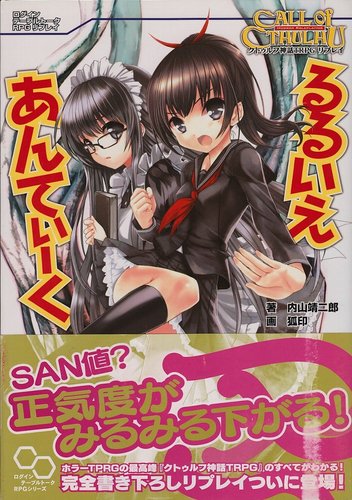
Source of image: http://www.amazon.co.jp/gp/customer-media/product-gallery/4047262390
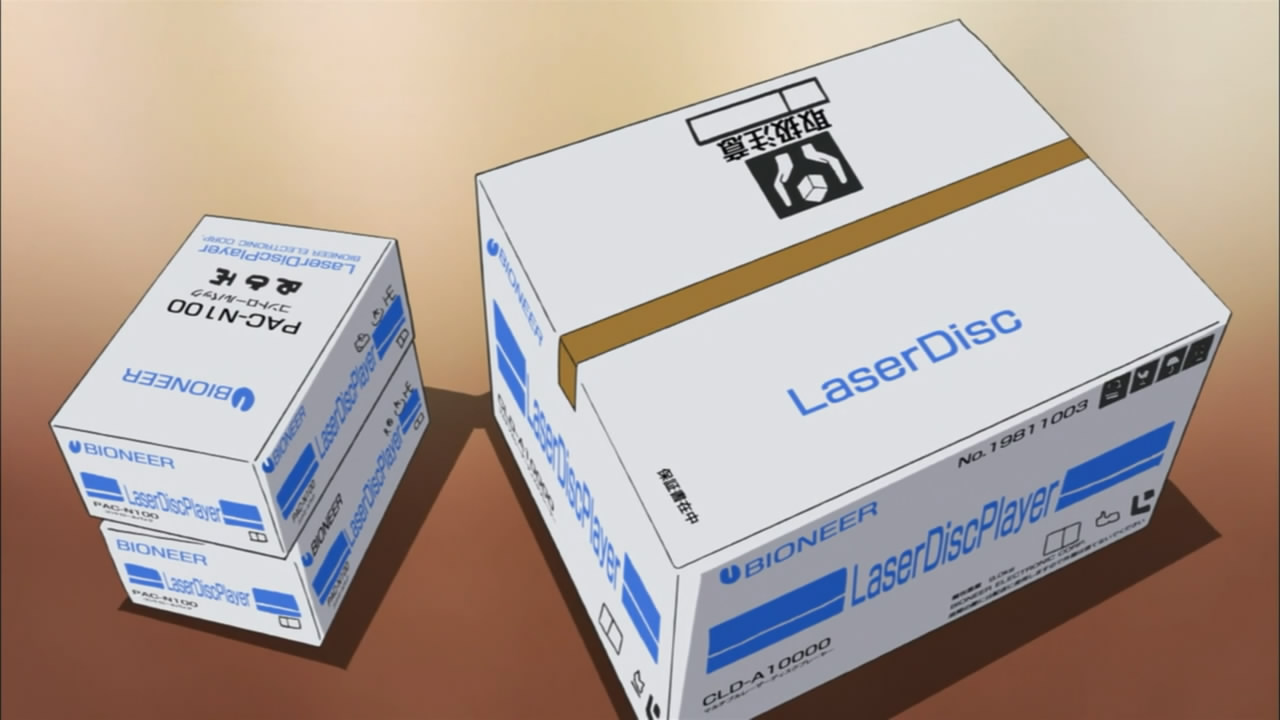
(9:52)
This is referencing the LaserActive (レーザーアクティブ), a video game console released by Pioneer (パイオニア) in 1993.S1 Text on the boxes reference specific aspects of this console:
• "BIONEER" is referencing Pioneer, the company that produced this console.
• "LaserDisc" is referencing how this console is capable of playing LaserDiscs.
• "CLD-A10000" is referencing "CLD-A100", the model number of this console.
• "PAC-N100" is referencing "PAC-N1", the model number of an add-on for this console.
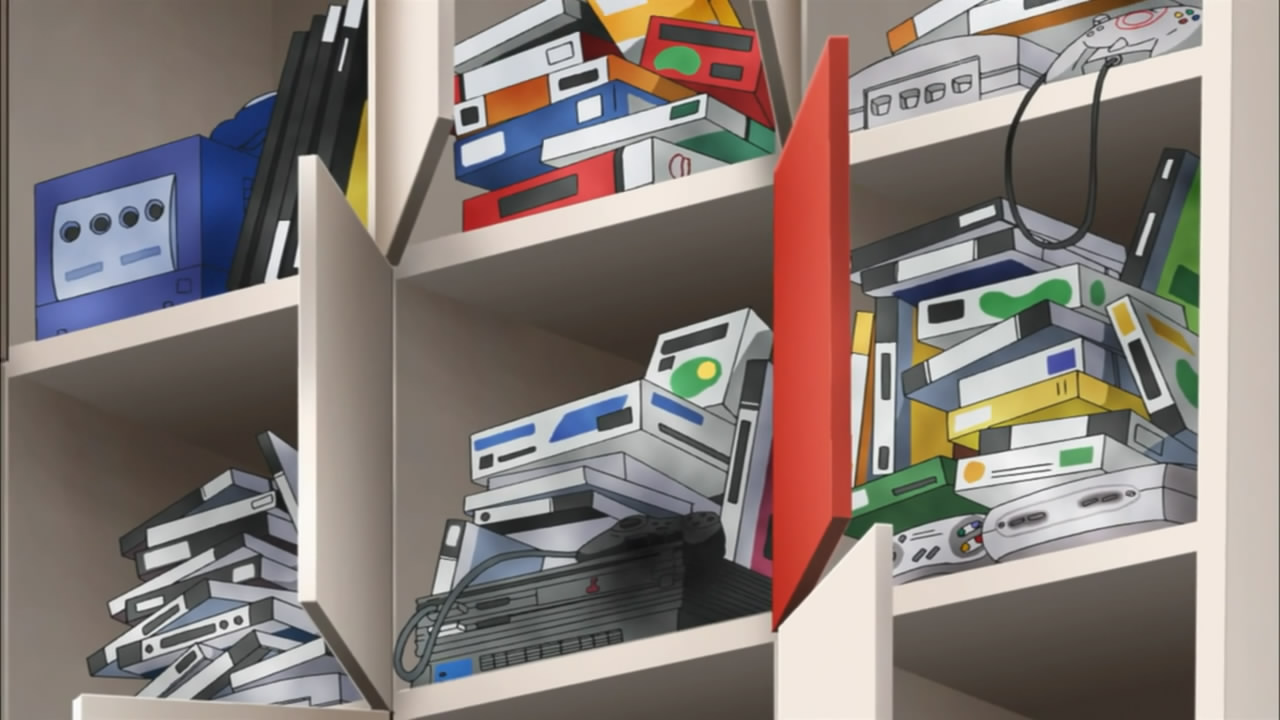
(10:00)
There are four references here:
• The device on the top left shelf is based on the Nintendo GameCube (ニンテンドーゲームキューブ), a video game console released by Nintendo (任天堂) in 2001. Image for reference:

Source of image: https://en.wikipedia.org/wiki/File:GameCube-Console-Set.png
• The device on the top right shelf is based on the Dreamcast (ドリームキャスト), a video game console released by SEGA (セガ) in 1998. Image for reference:

Source of image: https://en.wikipedia.org/wiki/File:Sega-dreamcast-set.png
• The device on the bottom middle shelf is based on the PlayStation 2 (プレイステーション ツー), a video game console released by Sony (ソニー) in 2000. Image for reference:
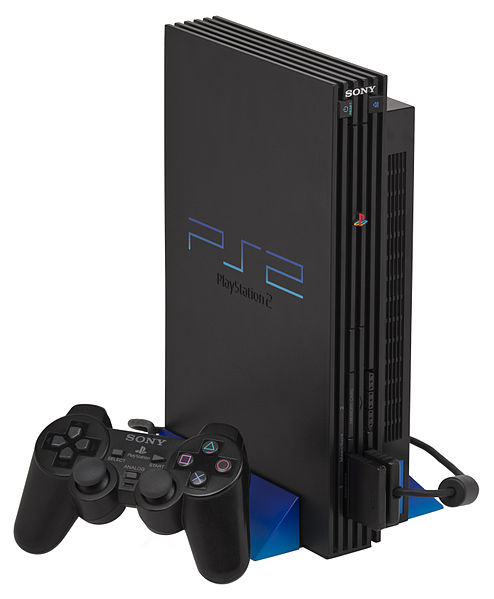
Source of image: https://en.wikipedia.org/wiki/File:PS2-Fat-Console-Set.jpg
• The device on the bottom right shelf is based on the Super Famicom (スーパーファミコン), also known as the Super Nintendo Entertainment System, a video game console released by Nintendo (任天堂) in 1990. Image for reference:
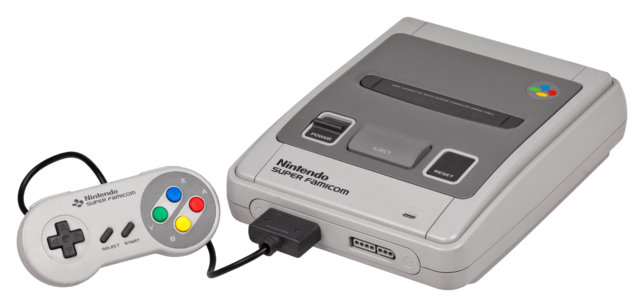
Source of image: https://en.wikipedia.org/wiki/File:Super-Famicom-Console-Set.png
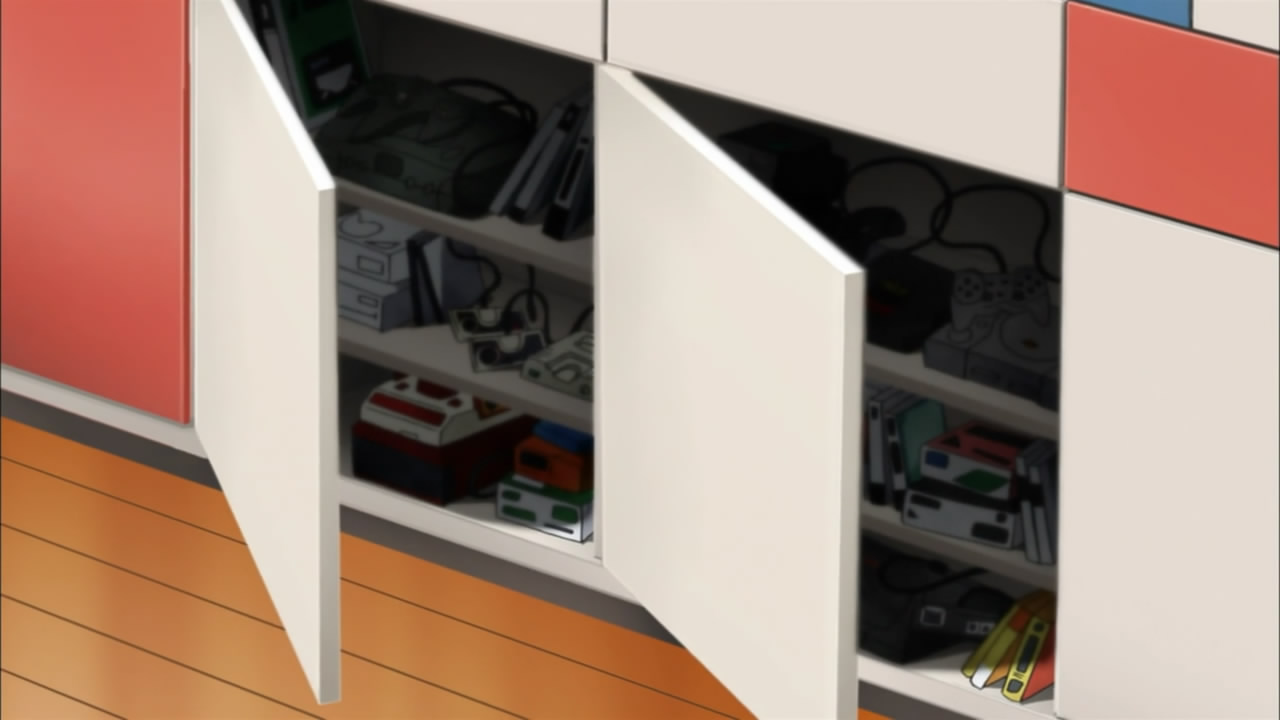
(10:03)
There are five references here:
• The device on the top left shelf is based on the Nintendo 64 (ニンテンドウろくじゅうよん), a video game console released by Nintendo (任天堂) in 1996.S1 Image for reference:
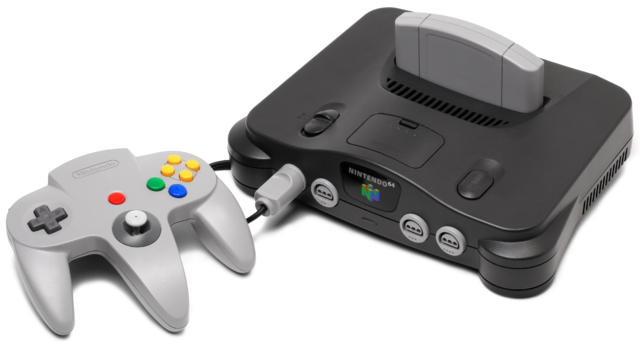
Source of image: https://en.wikipedia.org/wiki/File:N64-Console-Set.png
• The device on the top right shelf is based on the PlayStation (プレイステーション), a video game console released by Sony (ソニー) in 1994.S1 Image for reference:
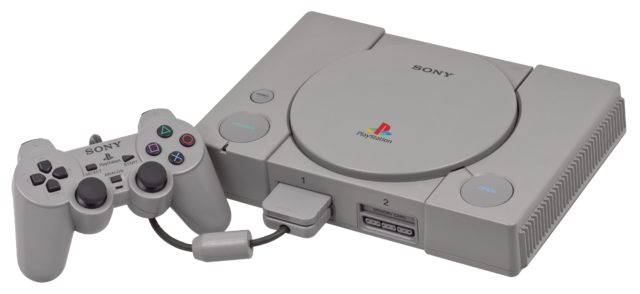
Source of image: https://en.wikipedia.org/wiki/File:PSX-Console-wController.png
• The device on the middle left shelf is based on the PC Engine (PCエンジン), also known as the TurboGrafx-16, a video game console released by Hudson (ハドソン) in 1987.S1 Image for reference:
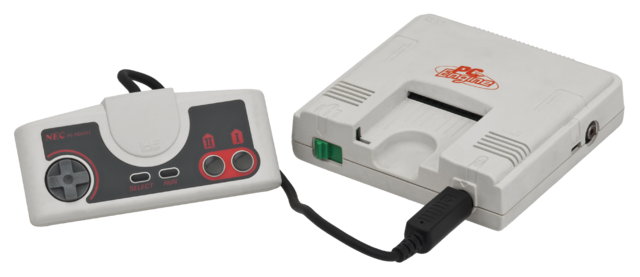
Source of image: https://en.wikipedia.org/wiki/File:PC-Engine-Console-Set.png
• The device on the bottom left shelf is based on the Family Computer (ファミリーコンピュータ), also known as the Nintendo Entertainment System, a video game console released by Nintendo (任天堂) in 1983. In addition, the device is mounted on a device based on the Disk System (ディスクシステム), an add-on for the Family Computer released by Nintendo in 1986.S1 Image for reference:
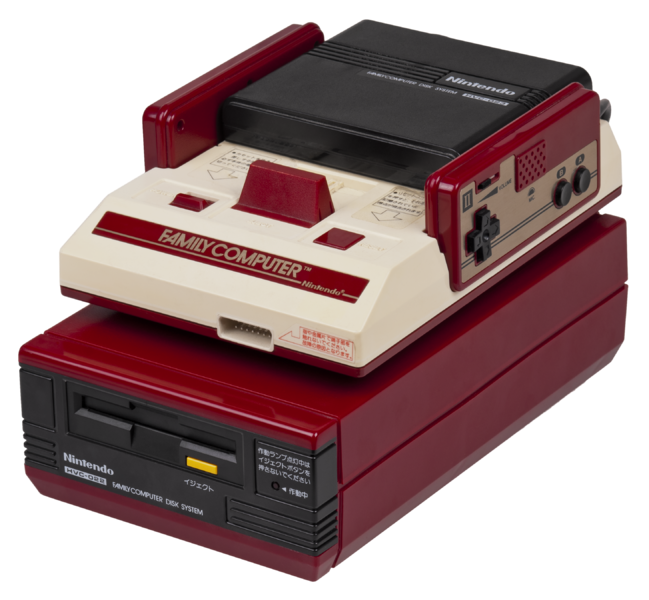
Source of image: https://en.wikipedia.org/wiki/File:Nintendo-Famicom-Disk-System.png
• The device on the bottom right shelf appears to be based on the Sega Master System (セガ・マスターシステム), a video game console released by SEGA (セガ) in 1986.S1 Image for reference:
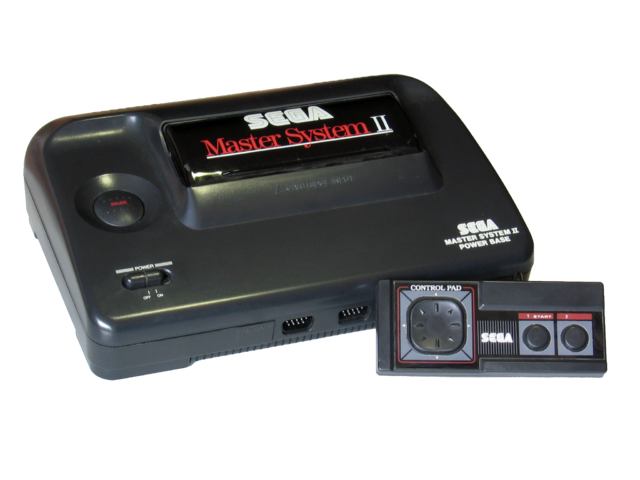
Source of image: https://en.wikipedia.org/wiki/File:Master_System_II_transparent.png
"Add lots of vegetables, oil and garlic!" (10:48)
The Japanese line is "Yasai mashi mashi arabu ninniku desu na!" (野菜ましまし油ニンニクですな!). This is referencing a famous chain of restaurants, Ramen Jirou (ラーメン二郎). At the restaurant, one can decide on toppings and the amount desired. According to a post at Ramen Tokyo,
Most shops have the following toppings/flavors/choices:So in reference to Nyaruko's "order", she wanted extra extra vegetables, oil, and garlic. If ordered at Ramen Jiro it would look something like this:
にんにく ninniku - garlic
野菜 yasai - veggies (beansprouts and cabbage)
脂油 abura - extra fat from the pot
辛め karame - means "spicy" or "with spiciness"
固め katame - means make the noodles "al dente"
You can also say "mashi" or "mashi mashi" to get extra or extra extra of that topping, e.g. "yasai mashi mashi ninniku" = extra extra veggies, regular garlic.
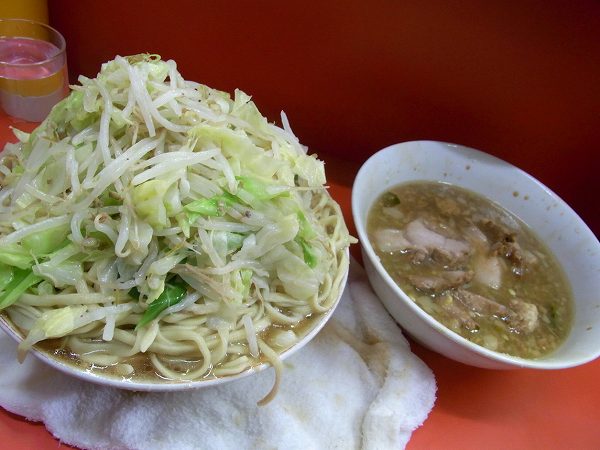
Source of image: http://tokyofood.blog128.fc2.com/blog-entry-44.html
On a related note, fans of Ramen Jiro call themselves "Jirorians" (ジロリアン Jirorian).S1
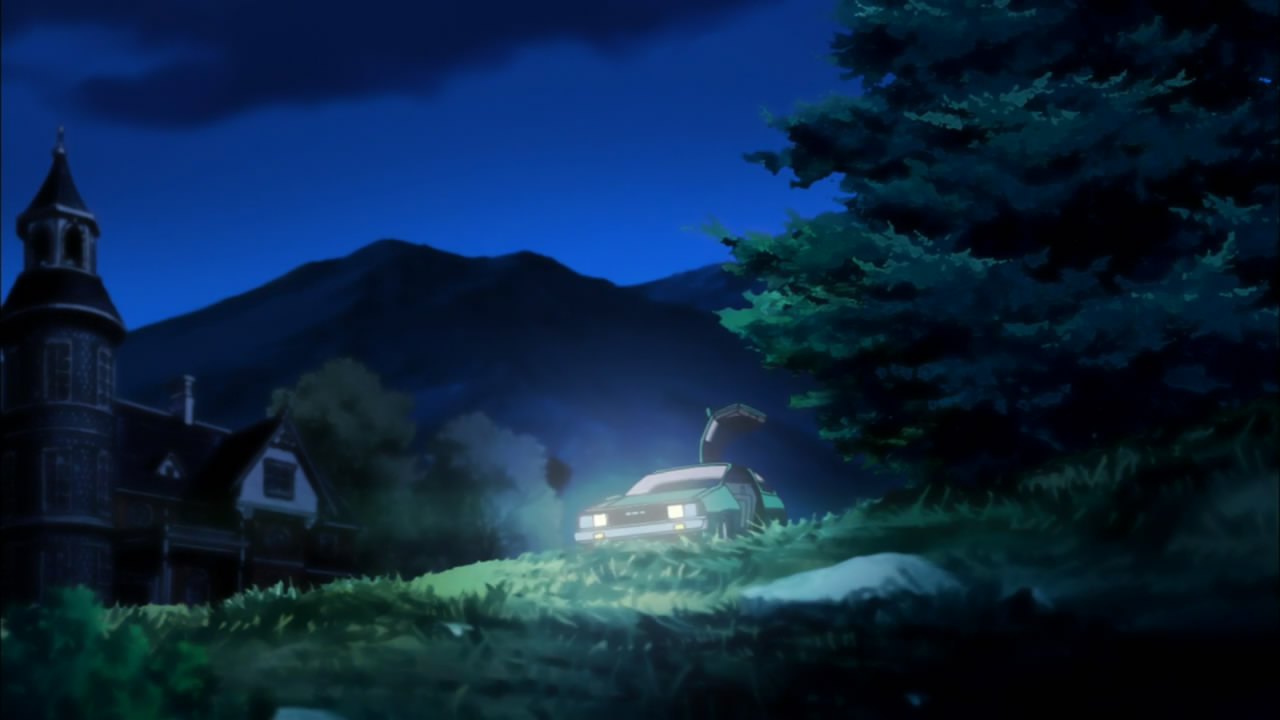
(10:55)
As a follow up to the previous line about "Jirorian", the car pictured here is a DeLorean DMC-12, which is pronounced as "Derorian" (デロリアン) in Japanese. The DeLorean is notable for its gull-wing doors and was made famous by its usage in the "Back to the Future" series. Images for reference:

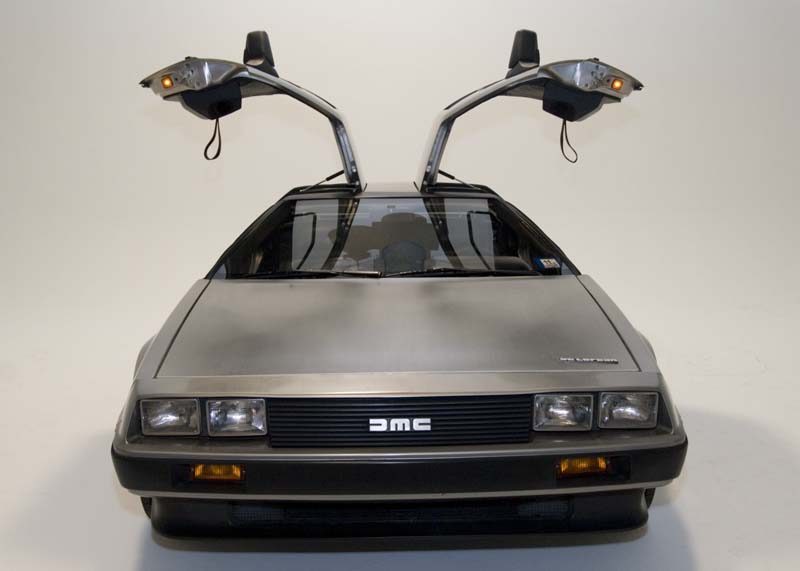
Image sources:
https://en.wikipedia.org/wiki/File:DeLorean_DMC-12_(9979).jpg
https://en.wikipedia.org/wiki/File:DeLorean_DMC-12_with_doors_open.jpg

(11:10)
Nyaruko's outfit and hairstyle are based on the cover art of "Haiyoru! Nyaruani 1&2 Perfect Box" (這いよる!ニャルアニ1&2パーフェクトボックス), a DVD box set released in 2011.S1 Image for reference:
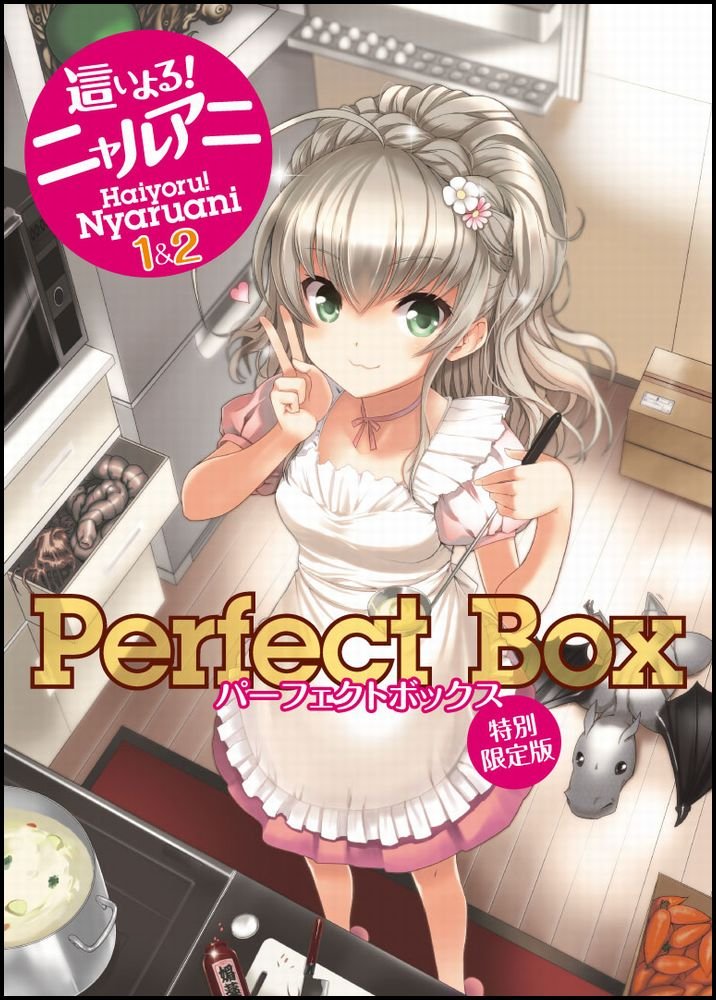
Source of image: http://www.amazon.co.jp/dp/4797363215
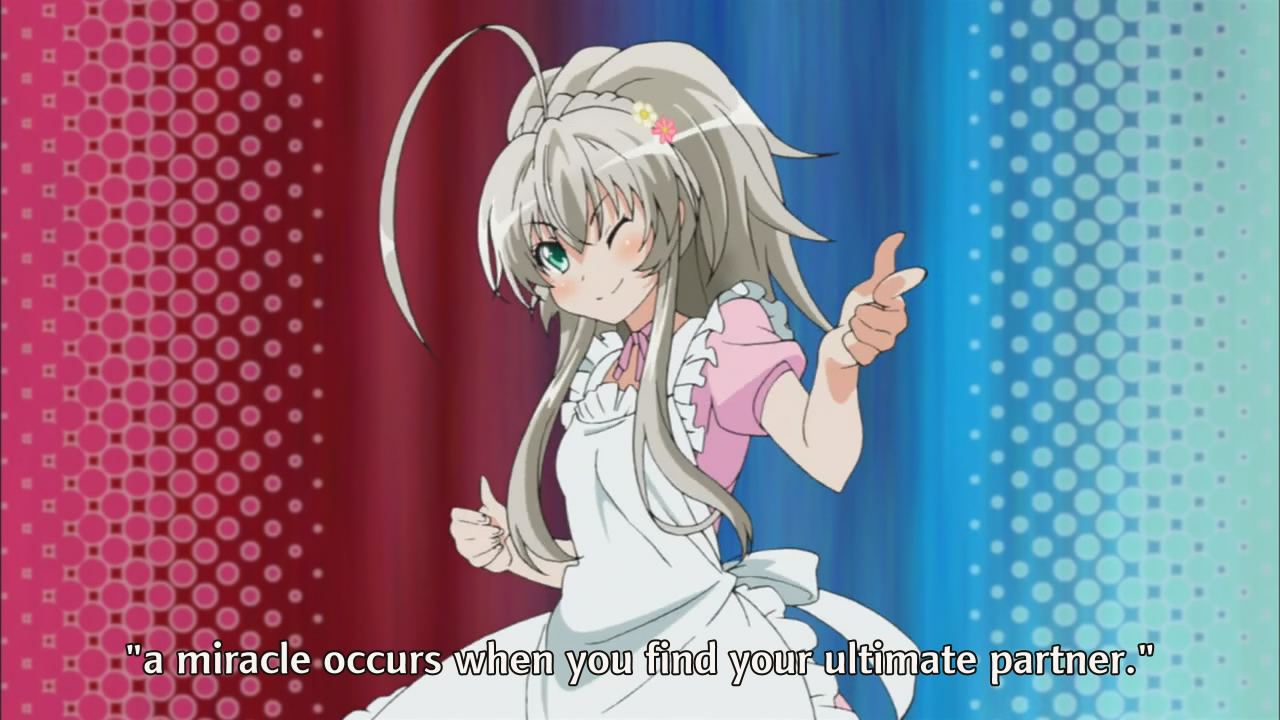
"A miracle will occur when you find your ultimate partner." (11:18)
There are three references here:
* The Japanese line is "Saikou no paatonaa ga deau toki ni kiseki ha okoru" (最高のパートナーが出逢うときに奇跡は起こる). This is referencing a line in the lyrics to "W-B-X ~W-Boiled Extreme~", a song sung by Kamiki Aya (上木彩矢) with TAKUYA and released in 2009. This song is the opening theme song for "Kamen Rider W" (仮面ライダーW), a Japanese TV show about a masked super hero that aired from 2009 to 2010.S2 The original line is "Saikou no paatonaa deau toki kiseki okoru" (最高のパートナー出逢うとき奇跡起こる), which has the same meaning as above.
* The pose that Nyaruko makes is a reference to Kamen Rider W's signature pointing pose.S2 Image for reference:
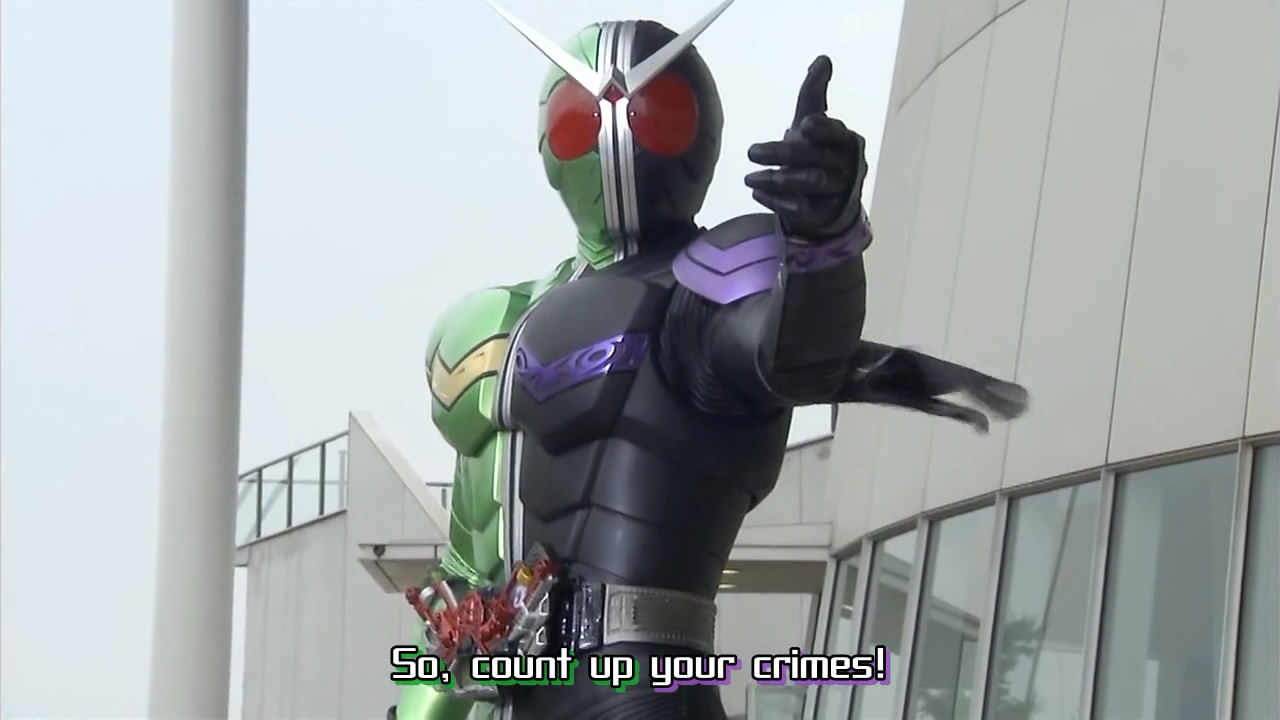
* The background is a reference to the color scheme of Kamen Rider W's Heat Trigger form. Image for reference:

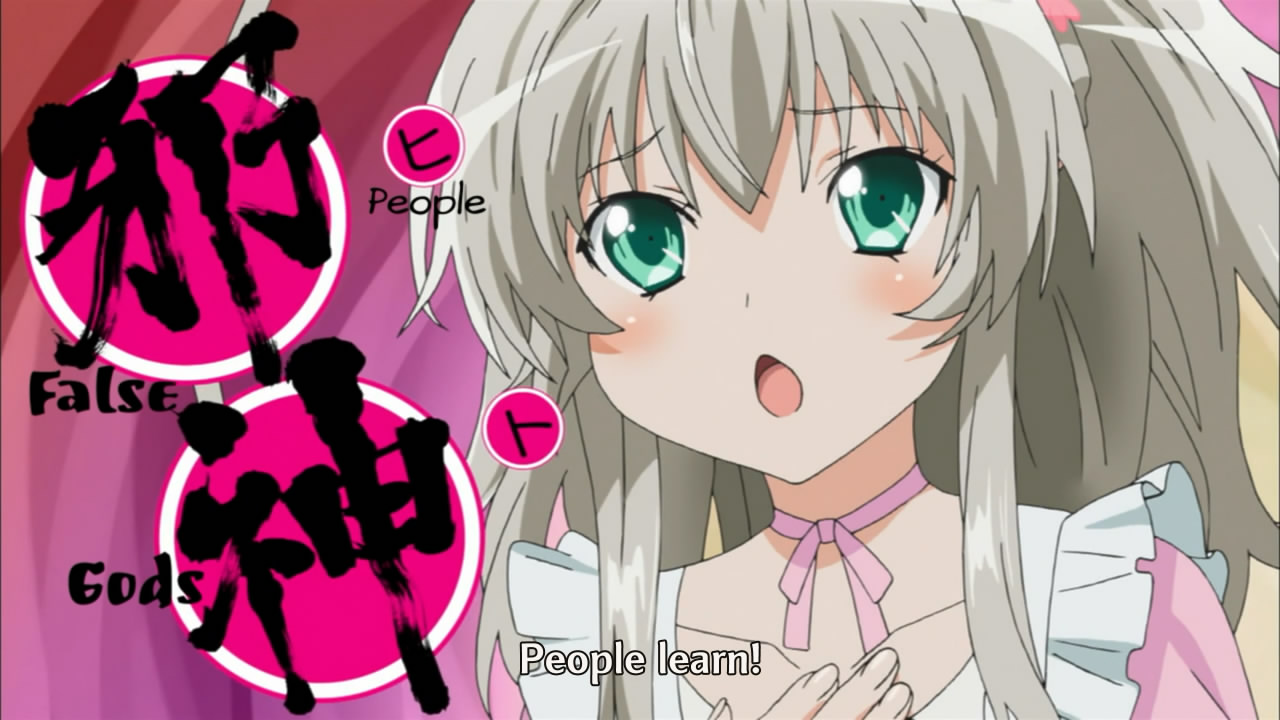
(11:37)
The large characters read 「邪神」 (jashin) meaning "evil god" while the smaller characters read 「ヒト」 (hito) meaning "person", stating that the text is written as "evil god" but read as "person". This is referencing a line from "At the Mountains of Madness", a story written by H. P. Lovecraft and first published in 1936. In the story, the main character discovers the remains of the Elder Things, a species of creature in the Cthulhu Mythos. After inspecting their ruins and learning of their past, the main character sympathizes with the Elder Things and realizes how human-like the Elder Things were, and exclaims, "Radiates, vegetables, monstrosities, star-spawn—whatever they had been, they were men!". In this way of thinking, Nyaruko is likening evil gods to people.S5
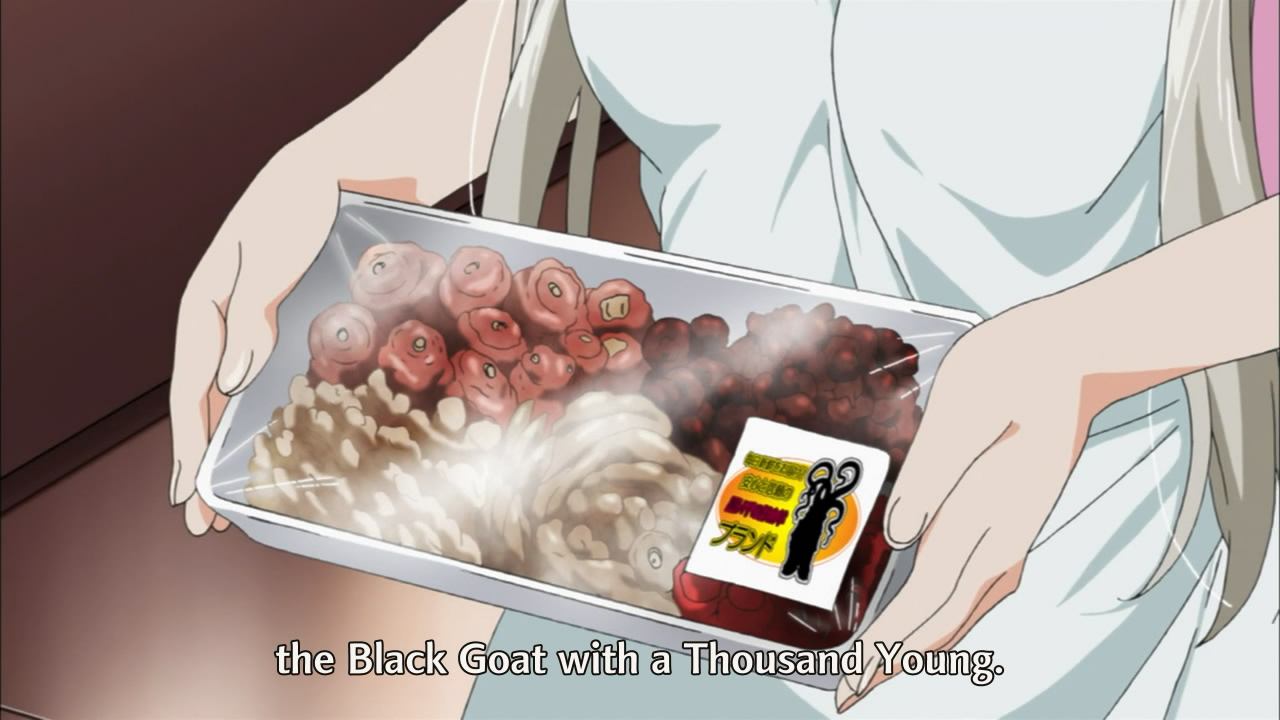
"It's Shub-Niggurath brand, the Black Goat with a Thousand Young." (11:44)
This is a reference to Shub-Niggurath, a deity in the Cthulhu Mythos often associated with the phrase "The Black Goat of the Woods with a Thousand Young", as mentioned in "The Whisperer in Darkness", a short story written by H. P. Lovecraft and first published in 1931.S2
"The X-oth and HS3 are the two favorites." (12:27)
There are three references here:
• "X-oth" is referencing the Xbox 360 (エックスボックス サンロクマル), a video game console released by Microsoft (マイクロソフト) in 2005.
• "HS3" is referencing the PlayStation 3 (プレイステーション スリー), a video game console released by Sony (ソニー) in 2006.
• "Ekkusu osu" (エックスオス), "X-oth", is referencing "Zosu" (ゾス), "Xoth", a binary star that exists in the Cthulhu Mythos.S1 In "The Thing in the Pit", a short story written by Lin Carter and first published in 1980, the following is stated:
"... the Spawn of Cthulhu came down from remote and ultra-telluric Xoth, the dim green double sun that glitters like a demonic eye in the blacknesses beyond Abbith, to whelm and reign over the steaming fens and bubbling slime pits of the dawn eons of this Earth..."
"Oh, I'm going to use a sonic bomb." (12:37)
"Oto bakudan" (音爆弾), "sonic Bomb", is a recurring item in "Monster Hunter" (モンスターハンター), a series of video games released by CAPCOM (カプコン) starting from 2004.S1 It is a small thrown projectile that emits a loud sound upon detonation to scare monsters.
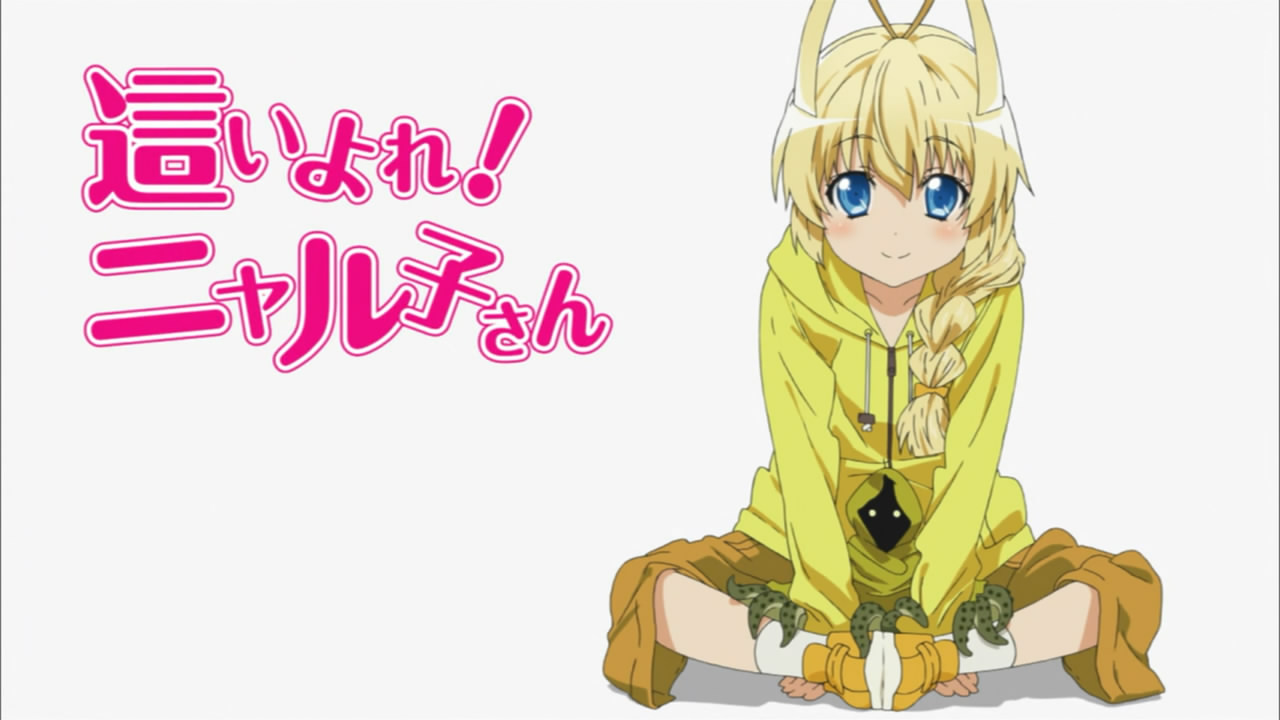
(12:46)
The creature in Hasta's lap is a depiction of Hastur, a creature classified as a Great Old One in the Cthulhu Mythos. The appearance of this depiction appears to be based on a depiction that appears in "Kyoufu to Kyouki no Kutourufu Shinwa" (恐怖と狂気のクトゥルフ神話), "Terrifying and Insane Cthulhu Mythos", a Japanese visual guide book to the Cthulhu Mythos released in 2009. Image for reference:
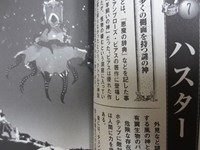
Source of image: http://d.hatena.ne.jp/servitors/20130410/p1
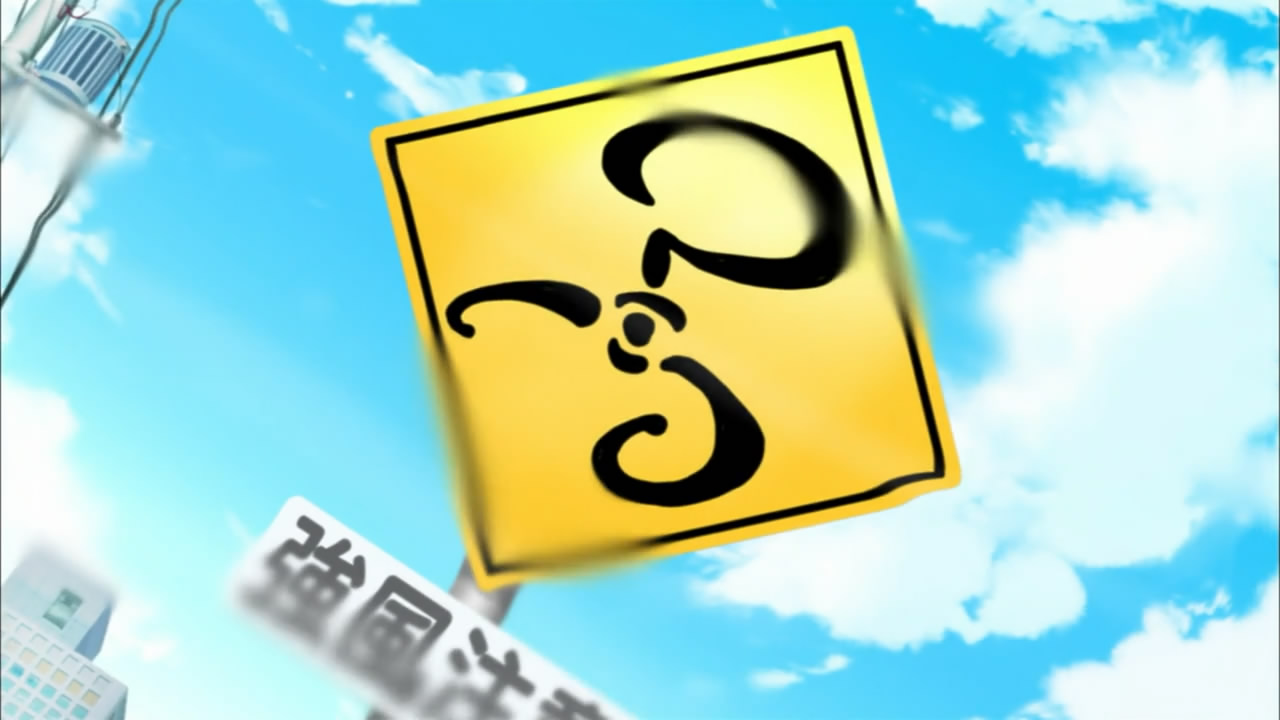
(12:57)
The sign has a depiction of the Yellow Sign, which is used as the sign of Hastur in the Cthulhu Mythos. Image from the 5th edition rule book for the "Call of Cthulhu" RPG for reference:

The windy conditions also allude to Hastur, since he is designated as an air deity in Derleth's elemental classifications.
"I knew you were a discerning man, Mahiro." (13:10)
The Japanese line is "Ome ga takai!" (お目が高い!), which translates to "You have good eyes!" in the context of discerning and understanding value in things. This is a catch phrase used in "Ani-com Radio" (アニコムラジオ), an internet radio show hosted by Asumi Kana (阿澄佳奈) and Fujiwara Keiji (藤原啓治) that aired from 2008 to 2011.S1 On a related note, Asumi Kana is the voice actor of Nyaruko.
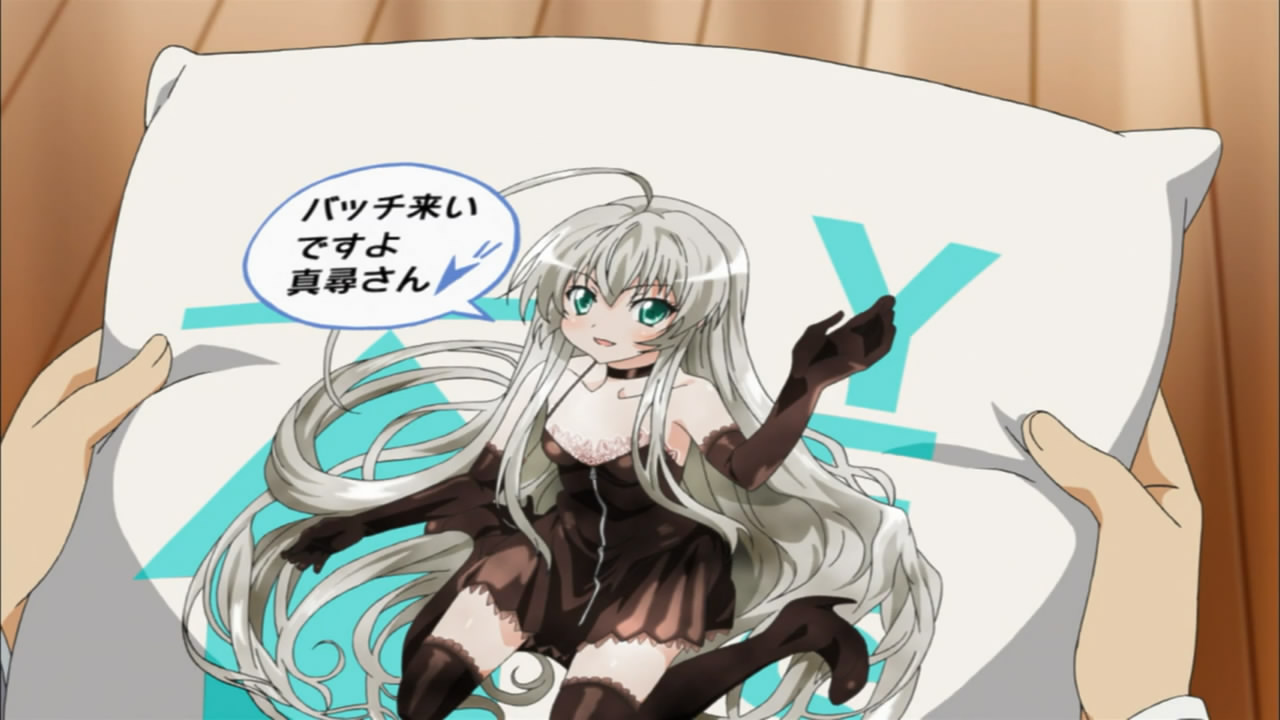
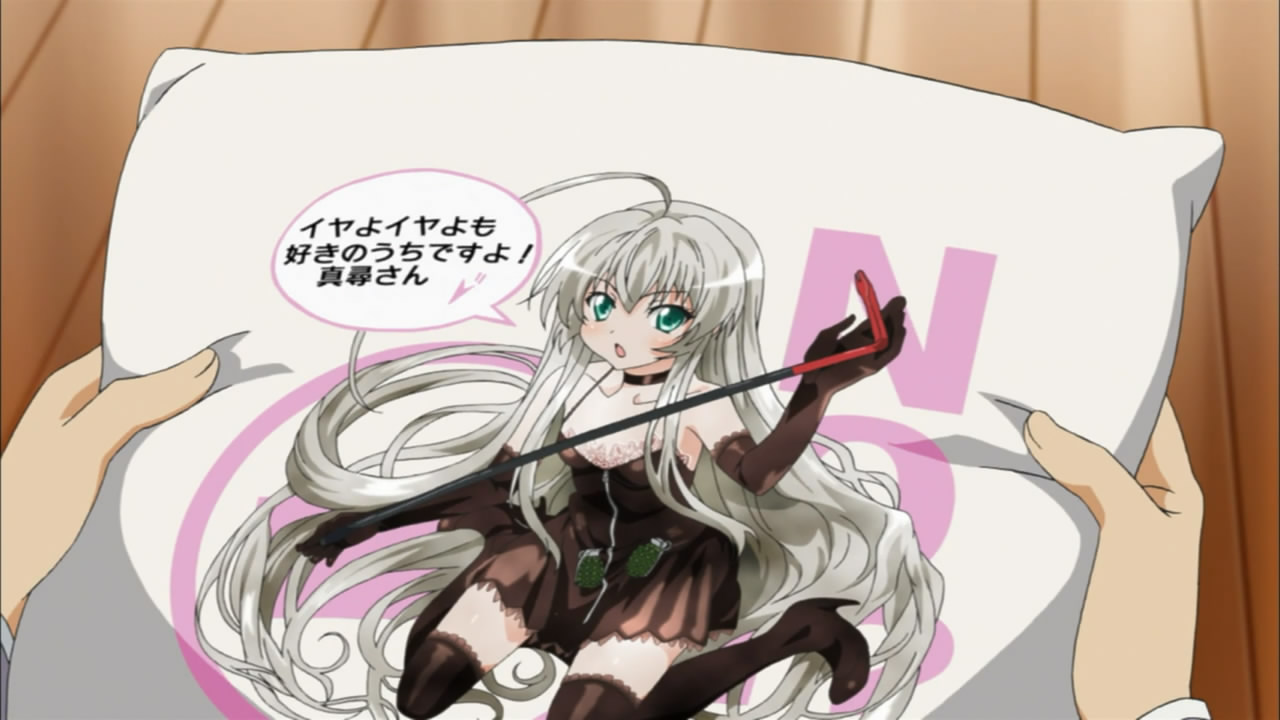
(13:16)
The Yes/No Cushion originated from the Japanese variety show, "Shinkon-san Irasshai!" (新婚さんいらっしゃい!), "Welcome Newlyweds!", where it is given as a gift. The depicted cushion is actually based on a real cushion being sold that was first released by GA Bunko at Comiket 77 in December of 2009.S1 Image for reference:
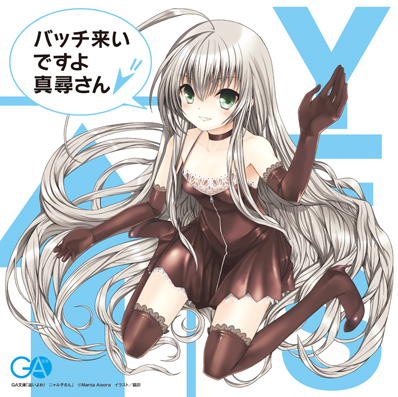
Source of image: http://ga.sbcr.jp/mgabunko/014255/
(13:56)
Cthuko's line at this time goes as follows:
「殴っていいのは、殴られる覚悟のあるやつだけ。」This is referencing a line in Japanese that goes as follows:
"Nagutte ii no ha, nagurareru kakugo no aru yatsu dake."
"Only those prepared to be hit, are allowed to hit others."
「撃っていいのは撃たれる覚悟がある奴だけだ。」This line is purported to be a translation of a line said by Philip Marlowe in chapter 31 of "The Big Sleep", a novel written by Raymond Chandler and published in 1939. The original line goes as follows:
"Utte ii no ha utareru kakugo ga aru yatsu dake da."
"Only those prepared to be shot are allowed to shoot others."
"Take my tip—don't shoot it at people, unless you get to be a better shot."However, the purported translation does not have the same meaning as the original line, and a source could not be identified that ties the purported translation to the original line. Additionally, prior to the airing of this episode of "Haiyore! Nyaruko-san" (aired on 2012/5/1) there is only one Japanese translation of "The Big Sleep" published, which was written by Futaba Juuzaburou (双葉十三郎) and published in 1956. This translation translates the original line as follows:
「ただし、もっと腕前が上がるまで、ひとさまを射っちゃいけないぜ。」Regardless of where or how the purported translation originated, it has become a well known line associated with Philip Marlowe and "The Big Sleep", and it has been referenced in other works of fiction. As a result, Cthuko's line may be referencing the following:
"Tadashi, motto udemae ga agaru made, hito sama wo uccha ikenai ze."
"However, until your skills improve, don't shoot at people." (translation back into English)
* This is referencing a line said by Lelouch Lamperouge (ルルーシュ・ランペルージ) in episode 1 of "CODE GEASS Lelouch of the Rebellion" (コードギアス 反逆のルルーシュ), an anime series that aired from 2006 to 2007.S1 The line goes as follows:
「それとも気づいたか?撃っていいのは撃たれる覚悟がある奴だけだと。」* This is referencing a line said by Narumi Soukichi (鳴海荘吉) in "Kamen Rider × Kamen Rider W & Decade: Movie War 2010" (仮面ライダー×仮面ライダー W&ディケイド MOVIE大戦2010), a movie released in 2009.S1 The line goes as follows:
"Sore tomo kizuita ka? Utte ii no ha utareru kakugo ga aru yatsu dake da to."
"Or have you realized? That only those prepared to be shot are allowed to shoot others."
「撃っていいのは撃たれる覚悟がある奴だけだぜ。」
"Utte ii no ha utareru kakugo ga aru yatsu dake da ze."
"Only those prepared to be shot are allowed to shoot others."
"Defeating you won't be so hard." (14:02)
The Japanese line is "Tanin wo makasu tte no ha sonna ni muzukashii koto ja nai desu yo" (他人を負かすってのはそんなに難しい事じゃないですよ). This is referencing lines said by Kishibe Rohan (岸辺露伴) in chapter 375 in Volume 40 of "Jojo no Kimyou na Bouken" (ジョジョの奇妙な冒険), "Jojo's Bizarre Adventure", a manga series written by Araki Hirohiko (荒木飛呂彦) and published starting from 1987.S1 His lines go as follows:
「他人を負かすってのはそんなむずかしい事じゃあないんだ・・・・・・」Images for reference:
「もっとも『むずかしい事』は!いいかい!もっとも『むずかしい事』は!『自分を乗り越える事』さ!」
"Tanin wo makasu tte no ha sonna ni muzukashii koto ja nai n da......"
"Mottomo 'muzukashii koto' ha! Iikai! Mottomo 'muzukashii koto' ha! 'Jibun wo norikaeru koto' sa!"
"Defeating others isn't such a difficult thing......"
"What is truly difficult! Listen up! What is truly difficult! Is surpassing oneself!"

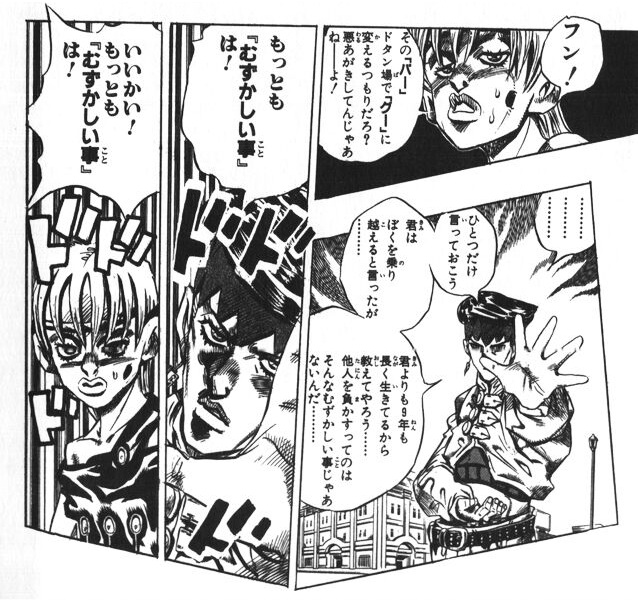
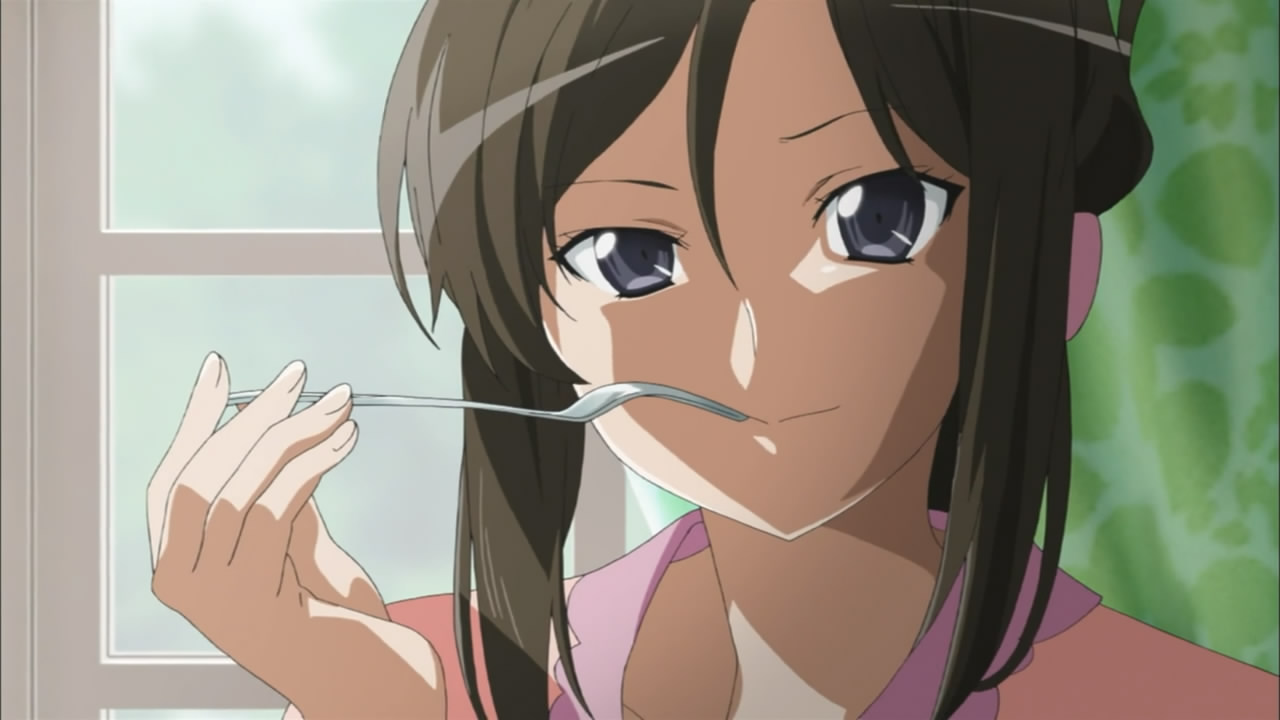
(14:15)
Yoriko's pose in this scene is mimicking that of Shikakenin Fujieda Baian (仕掛人・藤枝梅安), Assassin Fujieda Baian, from "Hissatsu Shikakenin" (必殺仕掛人), roughly "Professional Killers", a Japanese TV drama that aired from 1972 to 1973 and is part of the "Hissatsu" series (必殺シリーズ), "Certain Kill" series.S1
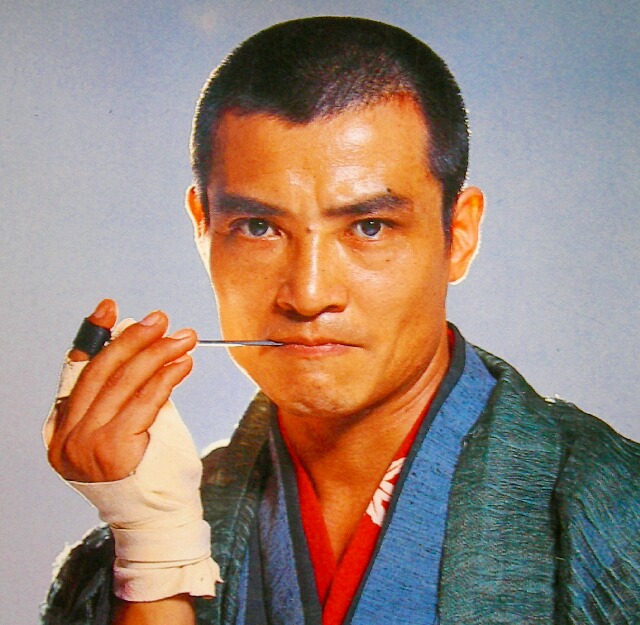
Source of image: http://spectre-nebura.cocolog-nifty.com/cultnight/2008/10/post-b28f.html
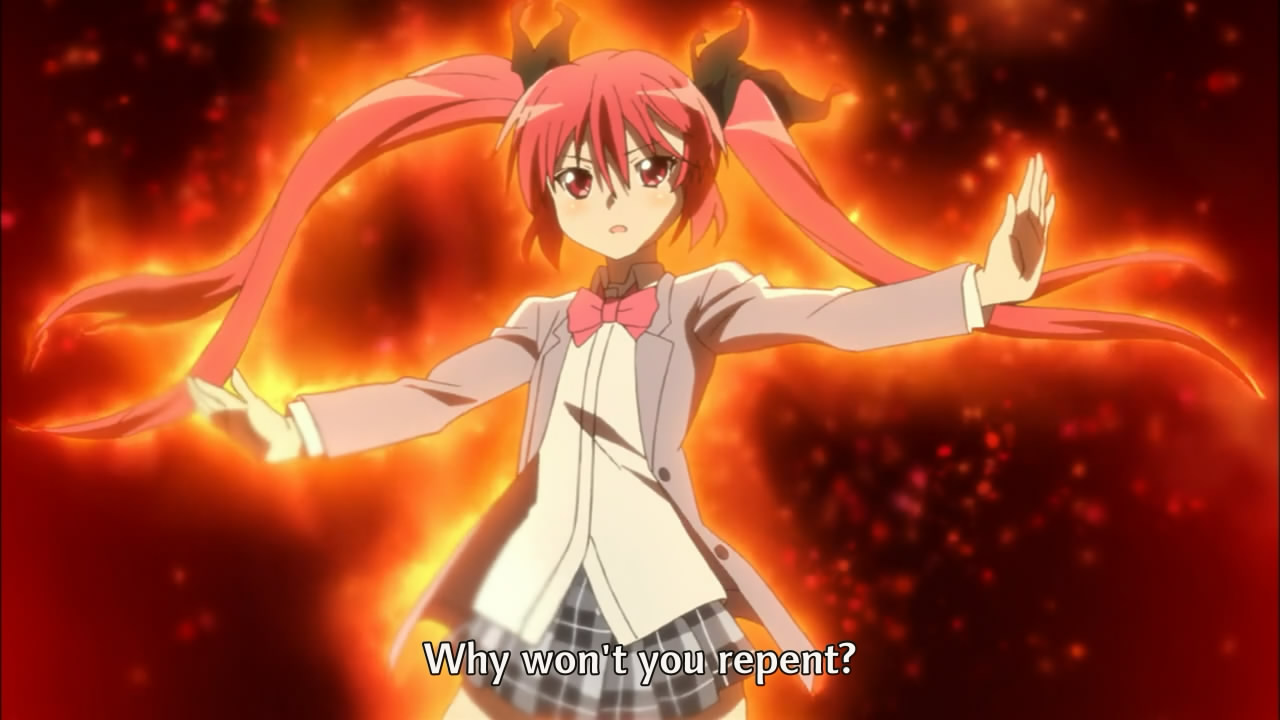
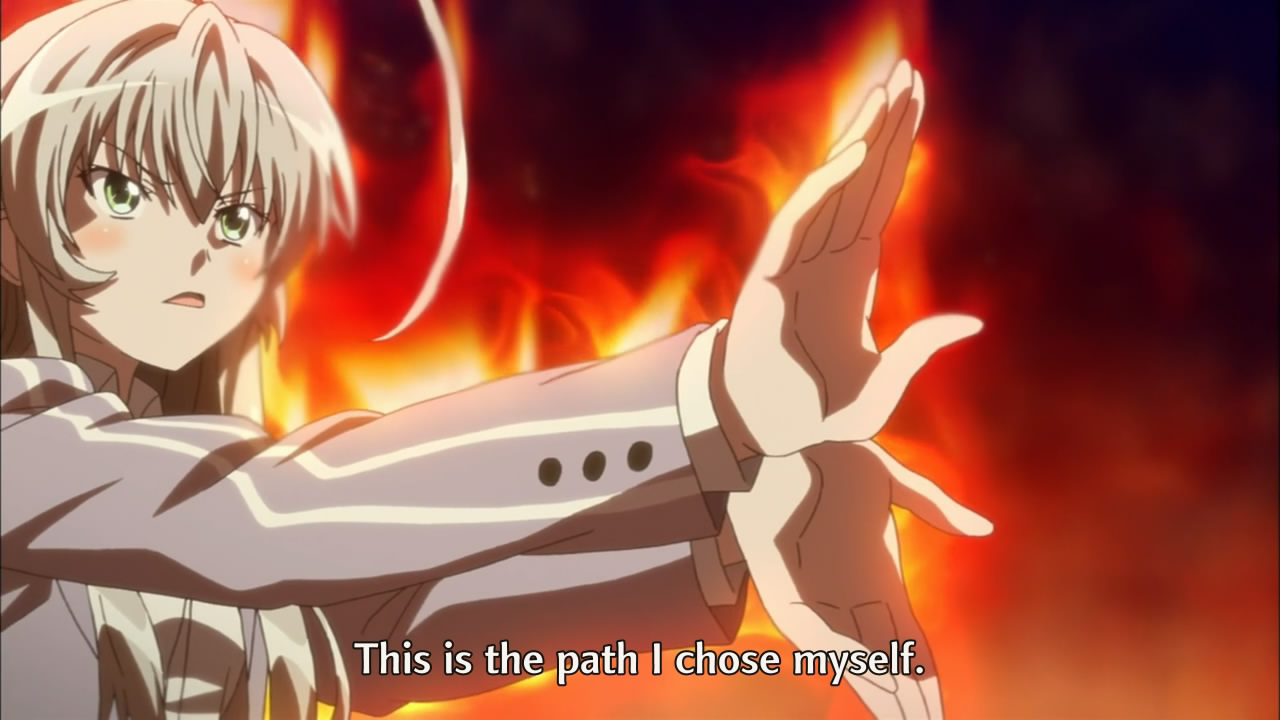
(15:54)
There are two references here:
* Cthuko's and Nyaruko's poses are referencing the fighting stances of Rei (レイ) and Kenshirou (ケンシロウ) respectively in chapter 36 of volume 5 of "Hokuto no Ken" (北斗の拳), "Fist of the North Star", a manga series written by Buronson (武論尊) and published from 1983 to 1988.S1 Image for reference:
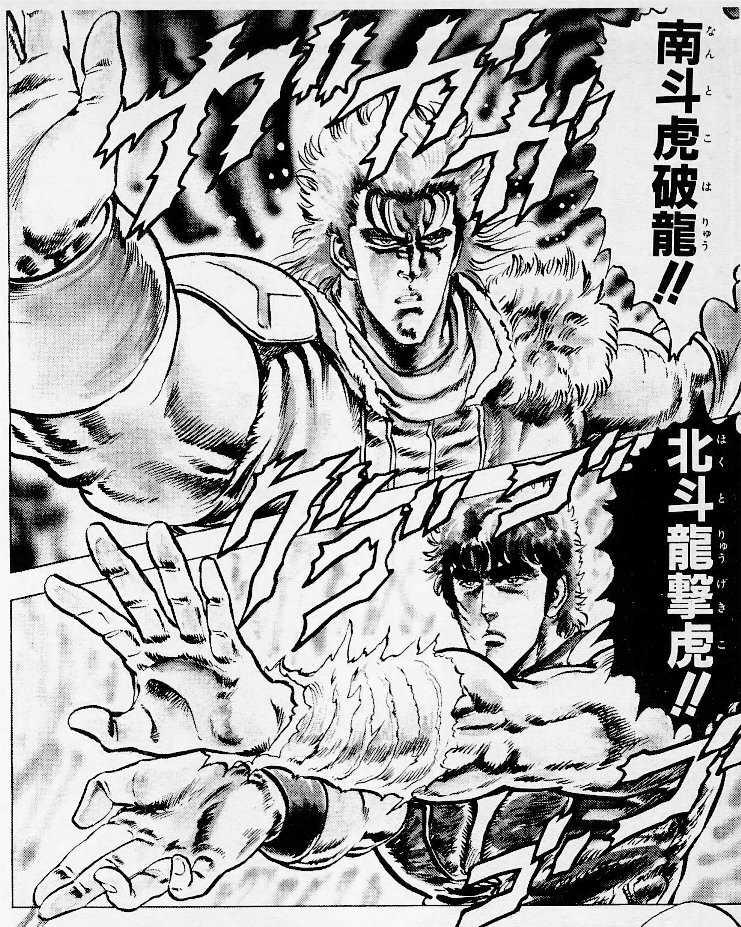
* The lines at this time go as follows:
クー子: 「後悔せぬか」This is referencing lines said by Raou (ラオウ) and Toki (トキ) in chapter 101 of volume 12 of "Hokuto no Ken" (北斗の拳), "Fist of the North Star".S1 The original lines go as follows:
ニャル子: 「自ら望んだ道、ためらいもない」
Cthuko: "Koukai senu ka"
Nyaruko: "Mizukara nozonda michi, Tamerai mo nai."
Cthuko: "Why won't you repent?"
Nyaruko: "This is the path I chose myself. I have no reservations."
ラオウ: 「後悔せぬか!!」Image for reference:
トキ: 「自ら望んで選んだ道 ためらいもない!!」
Raou: "Koukai senu ka!!"
Toki: "Mizukara nozonde eranda michi tamerai mo nai!!"
Raou: "Why won't you repent!?"
Toki: "This is the path I wished for and chose myself. I have no reservations!!"
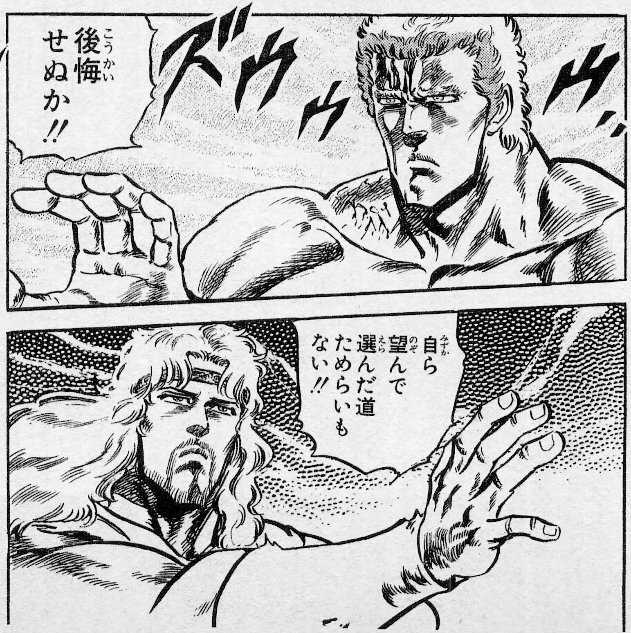
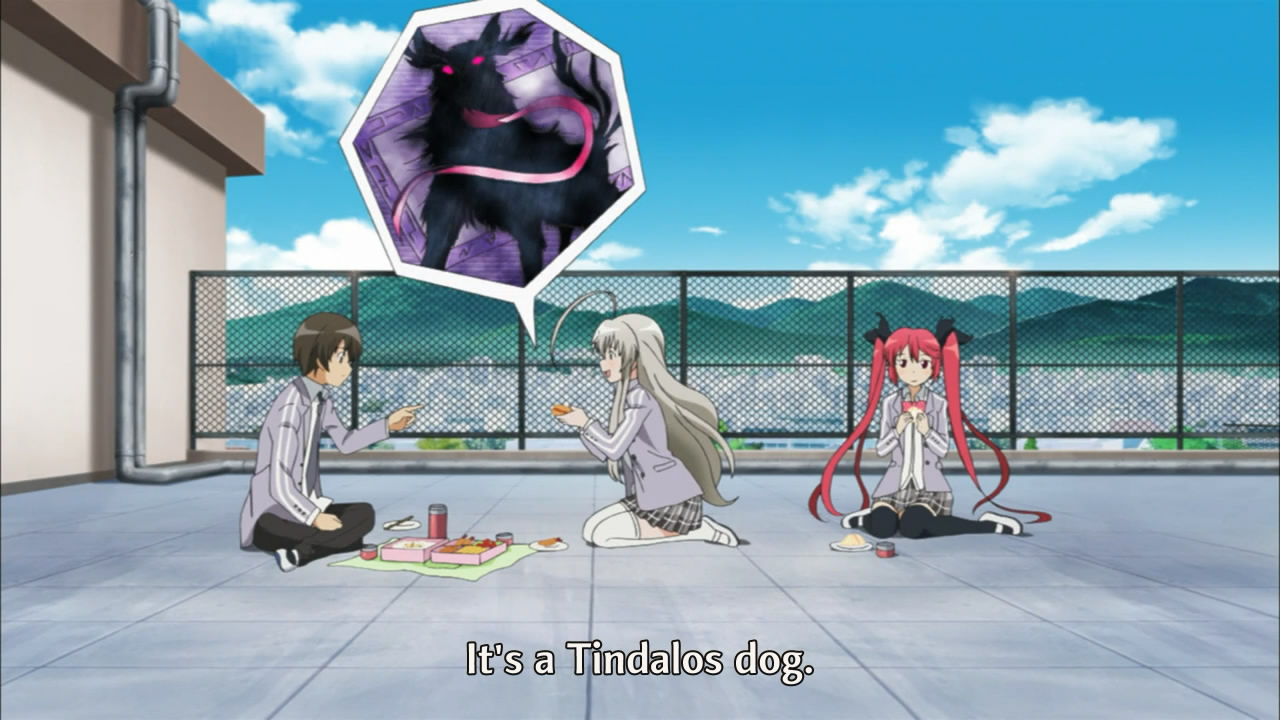
"It's a Tindalos dog." (17:35)
There are two references here:
* This is referencing the Hounds of Tindalos, a species of creature from the Cthulhu Mythos.S2
* The appearance of the Hound of Tindalos in this scene is based on a depiction of a Hound of Tindalos in "Ruruie Antiiku" (るるいえあんてぃーく), "R'lyeh Antique", an RPG replay book based on the "Call of Cthulhu" RPG that was written by Uchiyama Yasujirou (内山靖二郎) and published in 2009. On a related note, the illustrator for this book, Koin (狐印), is also the illustrator for the "Haiyore! Nyaruko-san" light novel series.S5 Image for reference:
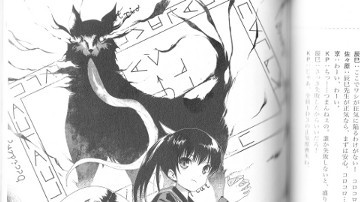
Source of image: http://f.hatena.ne.jp/servitors/20120502232948
"Go hit your head on the angles of time!" (17:37)
The Japanese line is "Jikan no kado ni atama wo butsukete koi!" (時間の角に頭をぶつけてこい!). This is referencing how the Hounds of Tindalos are said to inhabit the angles of time.S5 In "The Hounds of Tindalos", a short story written by Frank Belknap Long and first published in 1929, the Hounds of Tindalos are described as follows:
"The seeds of the deed move through angles in dim recesses of time."
(17:40)
The line at this time is "Eroba!" (えろばっ!), which has no specific meaning. This is referencing a line said by a minion of Raou (ラオウ) in chapter 65 of volume 8 "Hokuto no Ken" (北斗の拳), "Fist of the North Star".S4 Image for reference:
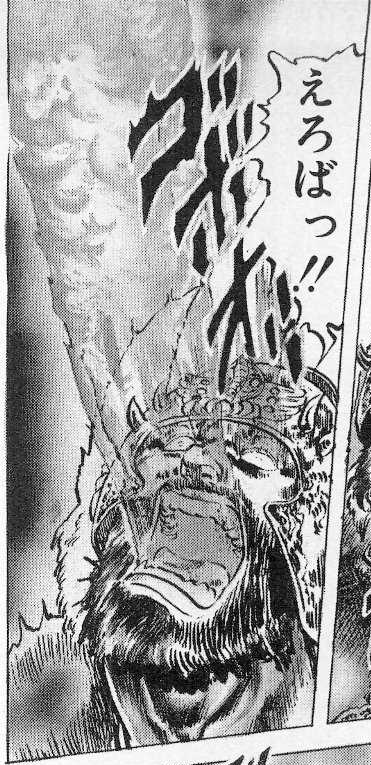
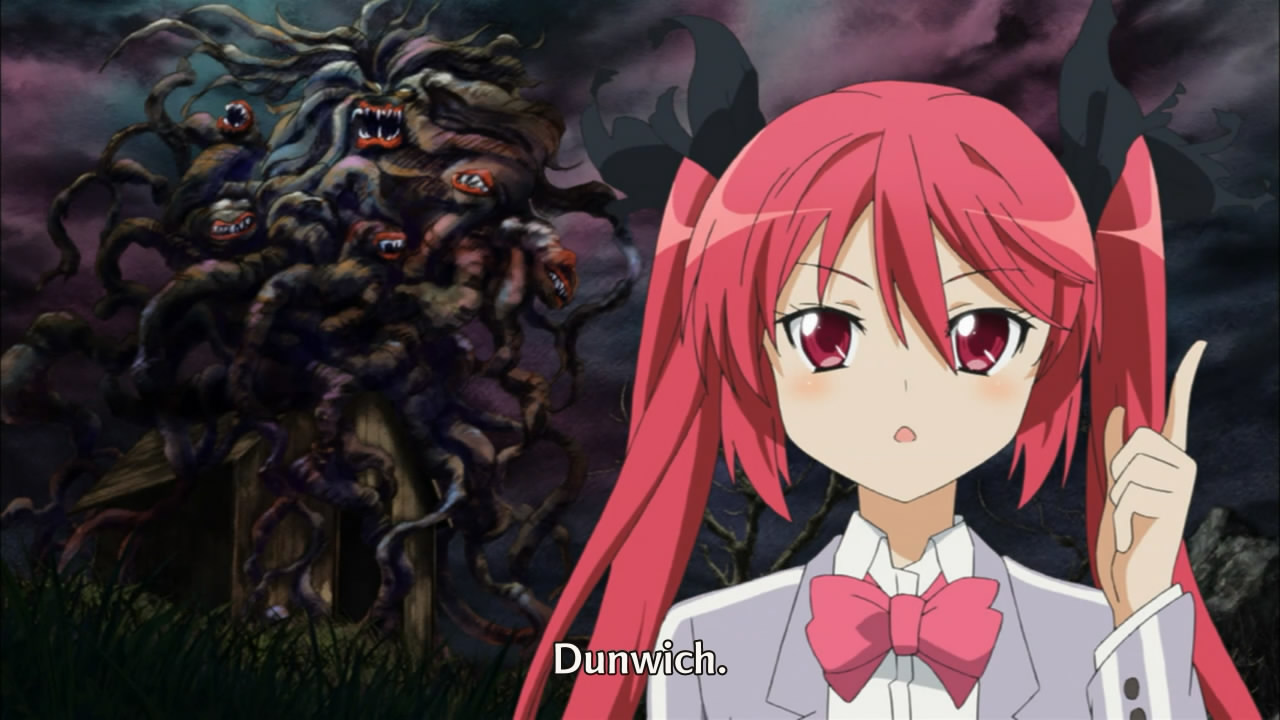
"Dunwich." (17:50)
This is referencing "The Dunwich Horror", a short story written by H. P. Lovecraft and first published in 1929. The story takes place in the fiction town of Dunwich, Massachusetts, and the creature shown in the background is a spawn of Yog-Sothoth bursting out of the confines of the Whateley farmhouse near the end of the story.S2
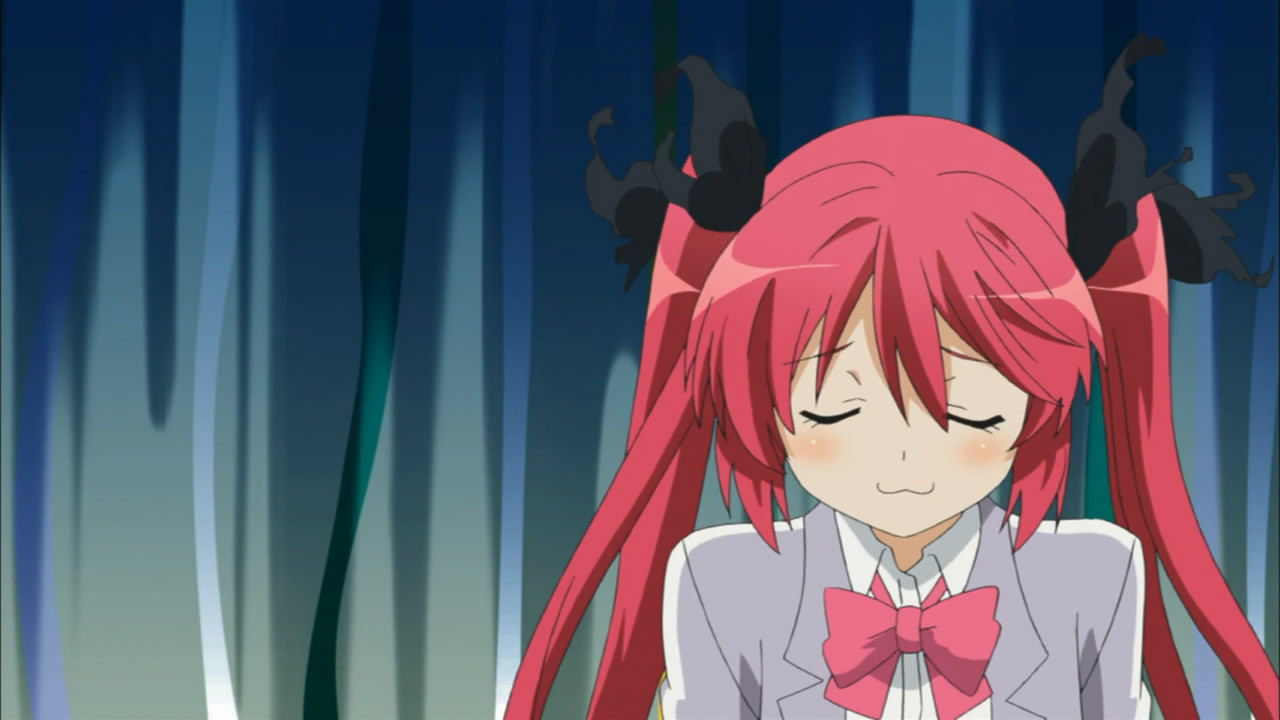
(´・ω・`) (17:55)
Cthuko says "Shoboon" (しょぼーん), an onomatopoeia for being sad or dejected. It's the name of the popularly used emoticon that her facial expression is mimicking.S1
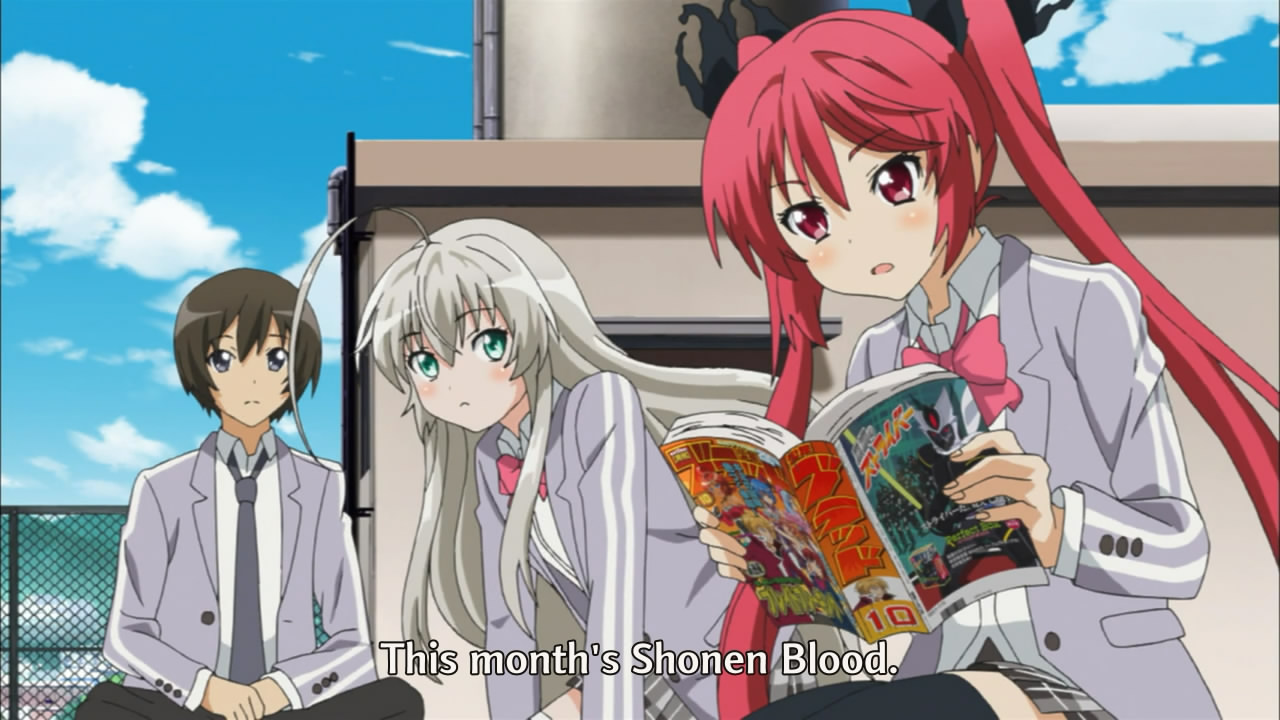
(18:14)
"Shounen Blood" (少年ブラッド) is a real Japanese manga magazine published by SOFTBANK Creative and MOVIDA Entertainment that was first released in April of 2006 and then discontinued after 7 volumes in October of the same year. The cover depicted is based on the cover of the 10th volume of "Shounen Blood" after it had become a web magazine.S1 Image for reference:
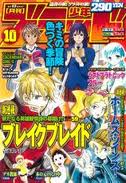
Source of image: http://steman.blog.fc2.com/blog-entry-767.html
On a related note, Softbank Creative is the company the publishes the "Haiyore! Nyaruko-san" light novel series.
"or consoles ahead of their time." (18:37)
This seems to be referencing the Sega Dreamcast. It was discontinued due to strong competition from other consoles at the time, but it has been regarded as ahead of its time since it was the first console to include a built-in modem and Internet support for online play.S4

(19:02)
The appearance of the dog in this scene is based on the pet dog Maron (マロン) belonging to Sairenji Haruna (西連寺春菜) in "To Love Ru" (とらぶる), a manga series written by Hasemi Saki (長谷見沙貴) and first published from 2006 to 2009. On a related note, the anime adaptation of "To Love-Ru" was animated by Xebec (ジーベック), the same studio that animates "Haiyoru! Nyaruko-san".S3 Image for reference:
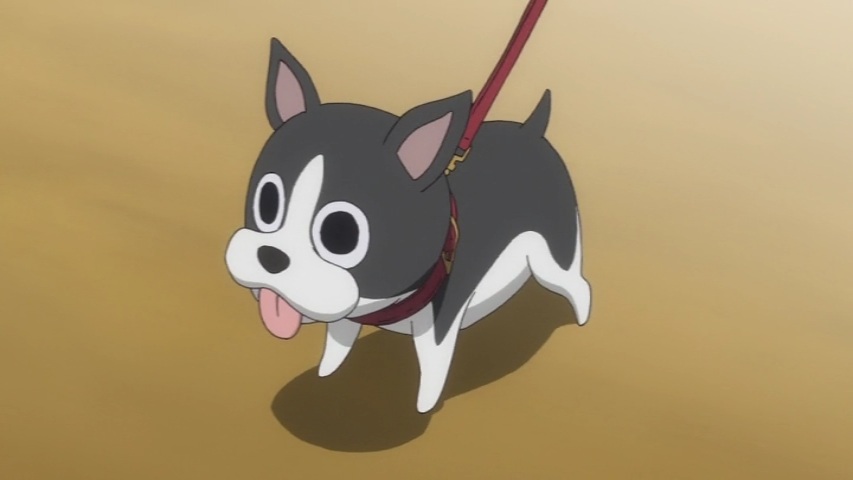
"We must be bound by the red string of fate, Mahiro." (20:03)
Like in episode 2 at 14:48, the red string of fate is an East Asian belief that destined lovers are connected by an invisible red string. It's similar to the notion of soul mates.
"The center of ultimate chaos told me to buy more." (20:13)
There are three references here:
* The center of ultimate chaos is referencing the deity Azathoth from the Cthulhu Mythos.S1 In "The Dreams in the Witch House", a short story written by H. P. Lovecraft and first published in 1933, Azathoth is said to be located "at the centre of ultimate Chaos."
* The Japanese line is "Kyuukyoku no konton no chuushin ga motto kae to sasayaita no desu" (窮極の混沌の中心がもっと買えと囁いたのです). This is referencing the endorsement wrapper (帯推薦文 obi suisen bun) attached to "Ruruie Hai Sukuuru" (るるいえはいすくーる), "R'lyeh High School", an RPG replay book based on the "Call of Cthulhu" RPG that was written by Uchiyama Yasujirou (内山靖二郎) and published in 2010.S4 The wrapper says,
『窮極の混沌の中心があなたにもっと買えと囁いています』byニャル子(逢空万太)Image for reference:
"Kyuukyoku no konton no chuushin ga anata ni motto kae to sasayaiteimasu" by Nyaruko (Aisora Manta)
"The center of ultimate chaos is whispering to you to buy more" by Nyaruko (Aisora Manta)
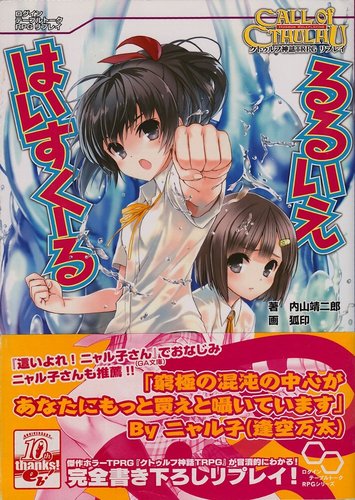
Source of image: http://www.amazon.co.jp/gp/customer-media/product-gallery/4047269077
* Both the line and the wrapper are referencing one of the catch phrases used for the fashion magazine, "Men's Knuckle" (メンズナックル Menzu Nakkuru). The original line goes, "Gaia ga ore ni motto kagayake to sasayaiteiru" (ガイアが俺にもっと輝けと囁いている), which translates to "Gaia is whispering to me to shine more".S1 Image for reference:
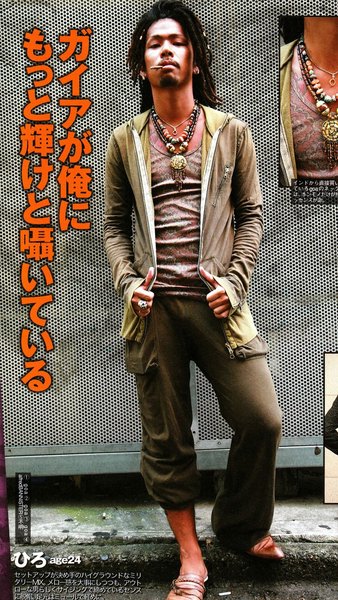
Source of image: http://www.inahostudio.com/neta/datewaru/mens/0711.html
"Hastur, the greatest deity of the wind?" (20:32)
Hasta (ハス太 Hasuta) is based on Hastur, a wind deity from the Cthulhu Mythos.

(20:55)
The sign to the right with the cat on it has the text "WiFi tsukaemasu!" (WiFi使えます!), "WiFi available!". This is referencing SoftBank and their free WiFi hot spots that are common in restaurants like McDonald's and Mos Burger. The sign that appears in the scene is also parodying the signs SoftBank uses to indicate the presence of WiFi hotspots and their mascot.S1 Image for reference:
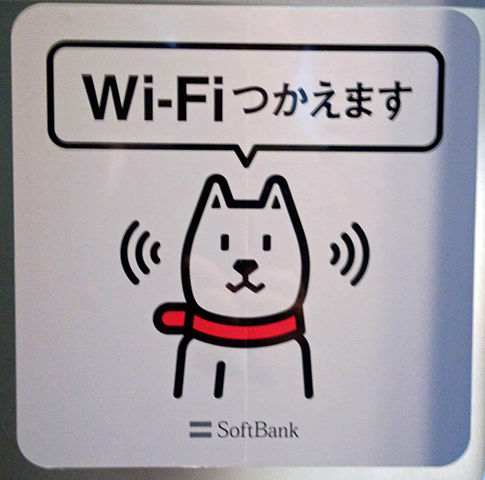
Source of image: https://ja.wikipedia.org/wiki/ファイル:SoftBank_WiFi.jpg
On a related note, the "Haiyore! Nyaruko-san" light novel series is published by SOFTBANK Creative, a subsidiary of SoftBank.
"Didn't you mention in one of your New Year's cards that you became a librarian at the Celaeno Library?" (21:12)
Celaeno is a star in the Taurus constellation and is a part of the Pleiades star cluster. In the Cthulhu Mythos there exists a great library on Celaeno, though it is unclear if it is located on Celaeno itself or on one of the planets that orbits Celaeno.S1 In "The Trail of Cthulhu", a book written by August Derleth and published in 1962, the Library is implied to be under the control and domain of Hastur, and contains "books and hieroglyphs stolen from the Elder Gods by the Great Old Ones".
(23:51)
What Nyaruko was about to say before Mahiro interrupts is "Reettsu! Konbain!" (レーッツ!コンバイン!), "Let's! Combine!". This is the catch phrase used in the next episode previews for "Choudenji Robo Kon Batoraa V" (超電磁ロボ コン・バトラーV), "Super Electromagnetic Robo Combattler V", an anime series that aired from 1976 to 1977.S1
List of sources:
S1. A post at Steman Blog (ステマブログ)
S2. Comments on episode 3 post
S3. Comments on this post
S4. Japanese Nyaruko References Wiki (這いよれ! ニャル子さん 元ネタwiki)
S5. A blog by servitors about Cthulhu Mythos inspired works (クトゥルー/クトゥルフ神話作品発掘記)
S6. A post by convexity
Thanks to everyone who contributed! This list wouldn't be nearly as long without you all. See you next episode!
情報を教えてくださって本当にありがとうございました!皆さんがいなかったら、このリストはぜんぜん長くありません。またこの次までね!
Last updated February 10, 2022
Sitemap
Home
